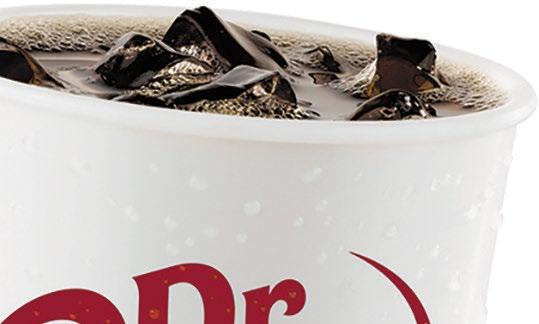






NFA Editorial Board
Rachel Jackson Editor-in-Chief rachelj@nfabk.org
Tyler Ryan Communications Editor tylerr@elevanta.com
Advertising Sales
Jeff Reynolds
Director of Business Partner Relations
jeffr@nfabk.org 678-797-5163
NFA Officers
Dan Fitzpatrick Chair
Jim Froio Vice Chair
Anthony Josephson
Secretary Steve Keith
Treasurer
Kevin Newell
Second Vice President
Christy Williams
CEO
NFA Board of Directors
CANADIAN
FRANCHISEE ASSOCIATION
Mike Kitchingman
FLORIDA/CARIBBEAN
Russ Lo Bello
GREAT MIDWEST
Rich Scanlan
Henry Delouvrier
Mark Peterson
GREAT WESTERN
Amir Allison
Nasser Aliabadi
Gary Geiger
INTERNATIONAL HISPANIC
FRANCHISEE ASSOCIATION
Adam Velarde
LARGE FRANCHISEE GROUP
Tom Garrett
METRO NEW YORK
Sanjay Patel
MID-ATLANTIC
Gary Andrzejewski
MID-SOUTH
Kevin Newell
Mike Callahan
Kevin Fernandez
Larry Stokes II
MINORITY
FRANCHISEE ASSOCIATION
Camille Lee-Johnson
NEW ENGLAND
Brek Kohler
OHIO RIVER
C.J. Timoney
Josh Lephart
SOUTHERN CALIFORNIA
Shirley Humerian
SOUTHWEST
Michael Laird
Design and Layout
KT Graphic Design
Kristen Thomas ktgraphicdesign@gmail.com
2024 Issue 3

2024 marks the 70th birthday of BURGER KING®! Turn to page 18 to read about the brand’s evolution since its establishment in 1954, as well as how BK® franchisees can continue to shape its history. To read about how franchisees can create unique, long-lasting experiences for their customers as a means to stand out and retain loyal clientele, turn to page 24.
02 70 Years of BURGER KING®, An Iconic American Brand by Dan Fitzpatrick, NFA chair
04 The Secret Behind 70 Years of BURGER KING® Success by Christy Williams, CEO
1701 Barrett Lakes Blvd. NW, Suite 180 Kennesaw, GA 30144 Phone: 678-797-5160 • Fax: 678-797-5170 www.nfabk.org


Franchisee Spotlight: Josh Lephart
Look, Listen, Read 16 One Topic: 10 Facts 17 Congressional Spotlight: Chuck Edwards (R-NC-11) 22 History Behind the Industry
10 Support the Vendors That Support Your Association
IB Editorial Calendar and Advertisers Guide *IB = Inside Back
18 The BURGER KING Brand: 70 Years in the Making 24 Building QSRs on Customer Experiences by Tyler Ryan, NFA communications editor
26 5 Critical Mindsets for Achieving a Great Customer Experience contributed by Heidrick & Struggles
30 Form 1-9: A Ticking Time Bomb by Douglas H. Duerr, Elarbee, Thompson, Sapp & Wilson LLP
32 How Little Wows Add Up To a Big Sale by Danny Snow, Snow & Associates Inc.
34 Elements of the Entrepreneurial Mindset Series: Element No. 6: You Are in a Relationship Business by Dan Coughlin, The Coughlin Co.
36 The Direction Correction Badge by David Allen, Getting Things Done
38 DOL Ruling on Salary Thresholds Explained contributed by Mize CPAs
40 Maintaining Your BURGER KING Property contributed by Lockton Cos.
42 Driving Restaurant Profitability With RSI’s Revenue Management Platform contributed by Restaurant Services Inc.
44 The Upgrade You Need for Your Drive Thru contributed by Xenial, A Global Payments Company

Presumably, it is not lost on us that 2024 marks the 70th birthday of the BURGER KING® brand. By measure of anniversary, the 70th is usually celebrated as a platinum anniversary.
It is remarkable to think that in 1954, two young men, Jim McLamore and Dave Edgerton, would take the courageous step to create a restaurant which, over time, would develop into a true American icon. McLamore and Edgerton were entrepreneurs facing all of the challenges that it takes to create an idea, a concept, nurture it through all of its early challenges and have the conviction and fortitude to see it to success.
Upon reflecting on BURGER KING’s 70th year, I wonder what McLamore and Edgerton would think about what the BURGER KING brand has become. I think they would be pleased that BURGER KING is one of the largest restaurant companies in America. I think that they would be shocked to understand that the BURGER KING brand is operated and marketed globally, touching nearly every corner of the world. Many people have dreamt the dreams of McLamore and Edgerton; however, seldom has our success been realized by others. What a remarkable tribute the BURGER KING brand of today is to McLamore and Edgerton’s inspiration and dream.
Shortly after its founding in 1954, our founders created another enduring icon: The WHOPPER®. As we all know, the strength of the WHOPPER brand actually exceeds that of the BURGER KING brand itself. America’s No. 1 burger, The WHOPPER, solidified the brand’s success through the present day. McLamore and Edgerton are to be congratulated for the legacy they created for all of us to carry on. On our behalf, I express to them our gratitude for allowing us to be a part of their historic achievement.
Over the years, the BURGER KING brand has enjoyed well-deserved highs and




some unfortunate lows. The sentiments I share in this article are insufficient to properly characterize the impact that this brand has made on so many. I am immediately drawn, though, to the impact that the BURGER KING brand has had on so many people and families, including my own. The BURGER KING brand has sustained thousands of franchisees who, in turn, have facilitated family fortunes, illustrious careers and millions of jobs.
All of us have heard franchisees comment that the BURGER KING business has been central to their professional life and family’s success. From the smallest franchisee to some of our largest, the BURGER KING brand has created for us not a job or a business, but a true vocation in our lives. What a gift it has been!
From the smallest franchisee to some of our largest, the BURGER KING brand has created for us not a job or a business, but a true vocation in our lives.
Turning 70 is a time when most people reflect on the “golden years” of life. However, for us, we are just getting started. Now is the time to pause in gratitude for the gift of this brand and, at the same time, to double our efforts to deliver the brand for the benefit of our guests, our teams and our communities. I am certain that the BK® management team will focus on this noteworthy accomplishment as we turn

by DAN FITZPATRICK
70 as a brand. Seventy years of success is somewhat of a rare occurrence in the history of brands that have long ago disappeared from the crowded landscape of companies. In this respect, the BURGER KING brand is special.
It is my hope that you will join me in reflecting briefly on all of the good this brand has done for so many. Moreover, I hope that you will also join me in recommitting ourselves to pursue the path of success and opportunity that this great brand offers to each and every one of us, every single day. So, thank you, Jim McLamore and Dave Edgerton, for the spark of sharing your idea with the world! Happy birthday to all of us! And remember, the best is yet to come! n
Sincerely,
Dan Fitzpatrick








Wow– SEVENTY YEARS of BURGER KING®! This is an accomplishment only achieved by truly iconic brands. There have been numerous quick-serve restaurant (QSR) brands over the past seventy years, but no one has stood the test of time and maintained its legacy status quite like BURGER KING.
One must ask the question, why? As someone who has worked among the franchisee community of this special brand for one-third of these past seventy years, I believe there are two major reasons BURGER KING became and remains an iconic household brand. First, and most importantly, is the franchisee community.
The BK® franchisee community is encompassed by leaders in the brand, in their own companies and in their local communities. Franchisees invest in their local communities and develop unbreakable bonds with their customers and the employees they hire and develop. I have referenced servant leadership in several columns in the past. I truly see the BK franchisee community in this way. In my years with National Franchisee Association (NFA), I have met the most considerate, selfless and intelligent franchisees who are the epitome of servant leaders.
The unique makeup of the franchisee community creates what I believe is the second secret to the brand’s success. This is the experience the franchisees create in their restaurants and local communities. Yes, customers love the product. Who does not love the flame-grilled goodness of a WHOPPER® or double cheeseburger from BK? Yet, the product is not the only reason the BK restaurant environment is special. It is the people within the restaurant. The leaders the franchisees invest


in. The employees who smile politely and remember regular customers.
As a child growing up in middle Georgia, our family rarely ate out at fast-food or casual-dining restaurants. The few and special times we did splurge, I clearly recall my brothers and I asking to go to the BK restaurant in Milledgeville, Georgia. NFA member and legendary BK franchisee Todd Schuster is the proud owner of this restaurant. Knowing what I do about Todd and his family business now, it makes sense that this is where our family chose to go on these dining-out occasions. Going to his restaurant was an experience. He had the most amazing playground that was like the “Disney World” of playgrounds to small-town Georgia children. Speaking of Disney, I still have those Disney movie-themed cups that were offered at BK restaurants in the mid-90s. They are somewhere in a box at my childhood home. Similar experiences and memories like this are held by millions of customers that the BK franchisee community has served and welcomed into their restaurants for the past 70 years.
The amazing franchisees and servant leaders are the reasons why this brand has succeeded and become a household name. They – YOU – are also the reason NFA was developed to serve the franchisee community for the past 36 years. The franchisee community has been the constant and key to the success of the brand.
Thinking about the two reasons I believe the brand has maintained its staying power and success over the past 70 years, (1) franchisee leaders and (2) the experiences they create for their employees, communities and customers, I am reminded of the NFA LEAD Conference. I

by CHRISTY WILLIAMS
do not think it is a coincidence that LEAD: Leadership, Exploration and Development culminated just a few short years ago in 2019. The purpose of LEAD is to embody everything that is special about this brand. LEAD is about franchisees helping one another, celebrating their employees, developing their teams, collaborating with the vendor and supplier community and celebrating and embracing being a part of this magnificent brand. We are excited to plan the 2025 NFA LEAD Conference at the most magical place on earth: Disney’s Coronado Springs, June 23-26, in Orlando, Florida. Plan now to attend, and let us continue to celebrate this wonderful brand, the franchisee community, above restaurant leaders and system suppliers, and prepare for the next 70 years of greatness for BURGER KING and NFA. n




AsBURGER KING® reaches its 70th year, franchisees across the nation are also reaching milestones in their history with the brand. Doug Barlow and Jay White, co-owners of Two Guys Foods Inc., have a partnership story that goes back over 40 years. At the beginning of the journey, White and his mother were operating two BURGER KING locations when they hired Barlow as a general manager. After a few years, the two decided to become partners and expand their operations to more restaurants. Over the course of the next 10 years, the two built and bought more BURGER KING locations.
Through decades of service to the BURGER KING brand, Barlow has come to appreciate the unique qualities of the business, such as the cooking methods and product quality. “Flame broiling and customization, especially in the earlier days of our franchising, have always differentiated us from our competitors.”
Currently, Barlow and White own and operate three locations and are based in downtown Boston. “Our partnership has been great,” Barlow said about the way the two have operated over the years, “We both bring different skill sets to the business. There are things he’s great at that I don’t particularly like to do, and vice versa, so we compliment each other from that standpoint. I think

that if both partners are trying to achieve individual agendas, it might not work as well as it would if they’re striving to work together so that we both succeed.”
After 38 years of partnership and even more years of overall experience in the business, Barlow feels that the key to thriving in the restaurant business is easier to achieve than many might believe: “We always strive to do the right thing and take care of our people and our customers. It’s a very simple recipe to success in the restaurant business. Sometimes, we may get lost in other complexities of the business and things we want to implement that aren’t necessary. If you focus on those two goals, to take care of your employees and to take care of your customers, they’ll take care of you.” n


GPS Hospitality (GPS), the third-largest BURGER KING® franchisee with close to 400 BURGER KING restaurants, has awarded BURGER KING FoundationSM scholarships to 235 students. The winners were chosen from communities where GPS’ restaurants are located including Alabama, Arkansas, Florida, Georgia, Louisiana, Maryland, Michigan, Mississippi, Pennsylvania, Tennessee, West Virginia and Texas. Since 2013, GPS Hospitality has supported 1,900 scholars, totaling nearly $1.965 million in giving for employees and high school seniors to continue their educational journey.
BURGER KING Foundation scholarships are awarded to graduating high school seniors based on their grade-point average and the impact the applicants have on their schools and communities through volunteerism and work experience. BURGER KING employees and their family members pursuing traditional post-secondary education or enrichment programs are also eligible to apply.
"At GPS Hospitality, we firmly believe that investing in the education of our future leaders is not just a choice, but a responsibility. These scholarships serve as a powerful testament to our commitment to this cause," said Michael Lippert, president of GPS Hospitality. "We are proud to continue to support the BURGER KING Foundation and provide educational opportunities to our hardworking employees and deserving high school graduates across the nation." n



JSCManagement Group, owned and operated by James Cammilleri, is deeply committed to supporting and enriching the communities it operates in. The first quarter of this year has been a testament to the company’s dedication, as it proudly backed numerous local sports leagues and events. JSC’s involvement reflects National Franchisee Association’s core belief in fostering youth development, promoting healthy lifestyles and nurturing a strong sense of community spirit.




JSC’s Support Highlights:
• Penfield Little League
• Greece Little League
• Eastside Little League
• Perinton Youth Soccer
• Trivia Night
• Lake Shore Little League
• Fairport Little League
• Rush Henrietta High School Football Team
• Perinton Youth Triathlon
• Eastern Connecticut State University
• Pickleball Tournament
• Willimantic Little League
• West Seneca Carnival
• Somerset Baseball League
• Hartford, Connecticut, Little League
By supporting these diverse programs, JSC Management Group aims to build a stronger, more connected community. Its efforts are geared toward encouraging youth participation in sports and fostering a sense of teamwork and camaraderie among young athletes.
Looking ahead, JSC Management Group is excited to continue its engagement with community programs. The company believes collective efforts can make a significant impact, helping to create a vibrant and supportive environment for all. n






GreatWestern Franchisee Association’s (GWFA) 2024 Summer Regional Meeting took place at the Hyatt Regency Lake Tahoe Resort, Spa and Casino in Incline Village, Nevada, July 14-16. As attendees arrived and registered, some participated in a friendly competition in the form of a pickleball tournament on Sunday afternoon. In the evening, the welcome reception and trade show were held, followed by a welcome dinner and casino night sponsored by The Coca-Cola Co.
Monday, July 15, began with a breakfast with vendors, sponsored by Restaurant365. During a closed business session, GWFA President Jennifer Geiger delivered a welcome presentation, followed by a secretary and business report by GWFA Secretary Mara Nunamaker, a financial update from GWFA Treasurer Sanna Sheere and vendor introductions and recognition by GWFA Vice President Ayaz Virji. National Franchisee Association (NFA) Secretary Anthony Josephson presented an NFA report, followed by a discussion led by NFA board members Gary Geiger, Nasser Aliabadi and Amir Allison. Occupational Safety and Health Administration (OSHA) delivered a presentation on changes in California law before a break in the session, sponsored by rapid! Pay Card. Luke Pisors, CEO of Ambrosia QSR, led a discussion on organizational structure, followed by a Government Relations







kick off the GWFA 2024 Summer Meeting with a lively pickleball tournament.
After a vendor appreciation lunch, the afternoon session began with Ayaz Virji sharing the latest update from the BKC Ops Council. Steve Keith and Jennifer Geiger followed with an update from the Image Committee. Attendees then heard presentations from NFA vendor partners, gold sponsor Restaurant365 and platinum sponsor The Coca-Cola Co. Following another break, sponsored by RTI, gold sponsor Xenial delivered a presentation. The session was closed out with an RSI update lead by Pat Webster, as well as a California meeting with BKC. That evening, attendees finished the day with cocktails and dinner, sponsored by Keurig Dr Pepper.

Attendees were able to enjoy beautiful views throughout their stay in Incline Village, Nevada.
Tuesday, July 16, began with breakfast with vendors and a passport drawing to deliver vendor and franchisee prizes to attendees. During a closed business session, platinum sponsor Keurig Dr Pepper presented, followed by an FZ tactical best practices presentation by Jon Aliabadi. The day ended with a BKC update from Peter Perdue, Gus Staknevicius and Chris Turpin. Attendees were able to participate in a round table discussion with BKC before the GWFA 2024 Summer Regional Meeting was officially adjourned. The GWFA Summer Regional Meeting is a prime opportunity for franchisees to strengthen their relationships with other BURGER KING® operators, as well as NFA’s vendor partners. Be on the lookout for news about future meetings! n
MidSouth Franchisee Association’s (MSFA) 2024 Summer
Regional Meeting took place July 28-30, allowing franchisees to mingle and hear presentations amidst the beauty of Hilton Head Island, South Carolina. The meeting kicked off on Sunday, July 28, with a welcome reception and trade show from 5 p.m. to 7 p.m. Franchisees then had the evening to explore Hilton Head on their own and enjoy dinner in the area.
Monday, July 29, began with a breakfast with vendors, sponsored by Xenial. Kevin Newell opened general session at 8 a.m., with an introductory presentation, followed by vendor introductions and then a best practices presentation by Newell.
The Coca-Cola Co., RSI and Xenial spoke about the value of their products and services to franchisees before National Franchisee Association Chair, Dan Fitzpatrick, delivered a presentation to session attendees.
After a lunch break with the vendors, sponsored by The Coca-Cola Co., the general session resumed with a Government Relations Committee update, followed by presentations by the VFW Foundation, Keurig Dr Pepper, RSI and KG4 Proficient Solutions. Russ Lo Bello closed out the session, and attendees were able to enjoy the rest of the evening with cocktails and a BBQ dinner on the beach pavilion.
On Tuesday, July 30, the final day of the meeting began with a 7 a.m., breakfast with vendors and ended with a general session, during which franchisees received brand updates from BURGER KING® Corp.
Regional meetings are always a great time for franchisees nationwide to connect and network. Stay tuned for communications regarding regional meetings throughout the rest of 2024! n


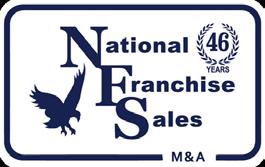
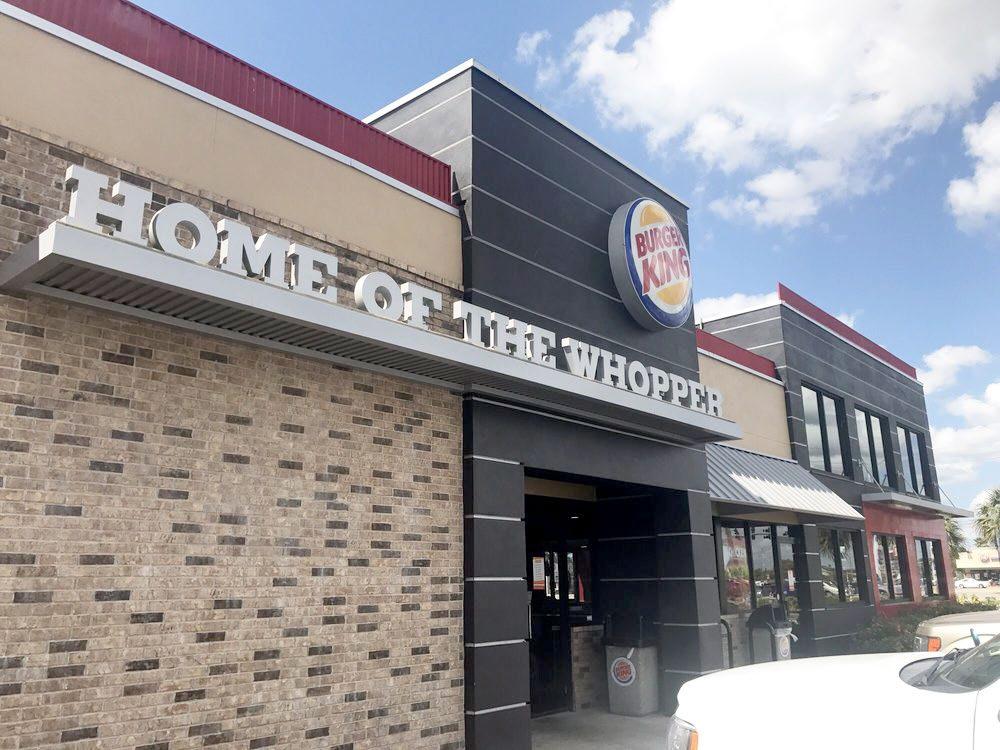




Elevanta Health
Green Dot Corp./rapid!
Hall Financial Advisors
Lockton Affinity
Mize Restaurant Group, providing Elevanta Payroll & Accounting Services
Keurig Dr Pepper
The Coca-Cola Co.
PAR
Lancer Worldwide
Restaurant Technologies
The Hershey Co.
Xenial
Allen Industries
Bixolon
BlueTriton Brands
Comcast Business
Ecolab
Gycor International
Restaurant365
Partner Caroline McShane memberservices@elevanta.com 678-797-5160
Partner Paul MacDonald pmacdonald@rapidpaycard.com 626-765-2890
Partner Kevin Knab kknab@hallfa.com 866-865-4442
Partner Reid Robson elevanta@locktonaffinity.com 844-403-4947
Partner Stacy Higgins shiggins@mizecpas.com 785-233-0536 X: 3103
Diamond Josh Hanley josh.hanley@kdrp.com 770-789-8266
Ruby Susan Miller skmiller@coca-cola.com 404-852-5399
Ruby Chad Casel chad_casel@partech.com 619-333-5060 X: 8273
Sapphire Greg Edwards greg.edwards@lancerworldwide.com 904-631-1031
Sapphire Ileana Barbara ibarbara@rti-inc.com 954-612-8086
Sapphire Steve Byrnes scbyrnes@hersheys.com 704-604-8745
Sapphire Nina Monsour events@xenial.com 313-550-2533
Pearl Betsy Swan betsy.swan@allenindustries.com 336-615-8791
Pearl Ann Klein aklein@bixolonusa.com 651-270-0700
Pearl Anitra Miller anitra.miller@bluetriton.com 321-863-0944
Pearl Dan Smith daniel_smith2@comcast.com 215-439-2524
Pearl Al Powell al.powell@ecolab.com 816-206-2513
Pearl David Rogers drogers@gycorfilters.com 800-772-0660
Pearl Lisa Rodkey lrodkey@restaurant365.com 717-269-0192
Shift Pearl Laura Lieder laura@upshow.tv 517-449-0876
Simplot
Tyson Foods
Upside
Welbilt
Pearl Brad Glover brad.glover@simplot.com 704-907-6522
Pearl Kathy Black kathy.black@tyson.com 410-340-3974
Pearl Ryan Gaylor ryan.gaylor@upside.com
Pearl Scott Baillargeon scott.baillargeon@welbilt.com 318-218-2775
Amazon Assoc. Mbr. Isaac Helu aisake@amazon.com 707-590-4158
Archmill House
Assoc. Mbr. Mike Donnelly mike.donnelly@archmillhouse.com 905-648-7330
Avery Dennison Assoc. Mbr. Darrin Briggs darrin.briggs@averydennison.com 435-421-2676
BILL Assoc. Mbr. Carli Smyth carli.smyth@hq.bill.com 801-922-0962
Bimbo Bakeries Assoc. Mbr. Steven Poole steven.poole@grupobimbo.com 678-918-6035
Budderfly Assoc. Mbr. Craig Norris craig.norris@budderfly.com 214-549-6936
Casablanca Design Group Assoc. Mbr. John Harrison john.harrison@casablancadesign.com 770-337-0931
Century Products LLC Assoc. Mbr. Alvis Alston aaa@centuryproductsllc.com 336-362-7393
Chatter by Stingray Assoc. Mbr. William Folsom wfolsom@stingray.com 386-208-9109
Cooper-Atkins Assoc. Mbr. James Kirk james.kirk@copeland.com 208-553-5425
C Squared Advisors LLC Assoc. Mbr. Peter DeFilippo pete@c2advisorygroup.com 401-525-6771
Current Lighting Assoc. Mbr. Dawn Kack dawn.kack@currentlighting.com 864-704-9987
DMI Manufacturing Inc. Assoc. Mbr. Denise Bangasser denise@dmiparts.com 440-975-8645 X: 138 DTiQ Assoc. Mbr. Doug Smith dsmith@dtiq.com 305-988-1020
Duke Manufacturing Assoc. Mbr. Toni McFeders tmcfeders@dukemfg.com 314-231-1130
Dynaxe Workforce Assoc. Mbr. Matthew O’Brien matt.obrien@dynaxecapital.com 813-842-6037
Eastern Bank Assoc. Mbr. Sean Perkins s.perkins@easternbank.com 203-350-9759 eb3.work Assoc. Mbr. John Dorer johnd@eb3.work 866-337-1403
Ecotrak Assoc. Mbr. Matt Singer msinger@ecotrak.com 888-219-0000 X: 2 Energybox Assoc. Mbr. Tony Carrella tony.carrella@energybox.com 973-500-2700
Entera Branding Assoc. Mbr. Matt Czajkowski matt@enterabranding.com 850-691-9652
Factura.ai Assoc. Mbr. Bradley Bloch bradley@factura.ai 647-231-3606
FCC Commercial Furniture Assoc. Mbr. Russ Cooley russ.cooley@fccfurn.com 541-580-3192
FranBizNetwork Assoc. Mbr. Carter Asefi carter@franbiznetwork.com 925-391-2724
Franke Foodservice Systems Assoc. Mbr. Wally Kisling wally.kisling@franke.com 615-751-7594
Frozen Beverage Dispensers (FBD) Assoc. Mbr. Joe Clements jclements@fbdfrozen.com 214-232-9555
Hermitage National Accounts Assoc. Mbr. Wyatt Culver wculver@gohermitage.com 615-714-6862
HME Assoc. Mbr. Stephen Lee slee@hme.com 864-508-1105
Horne Assoc. Mbr. Austin Hall austin.hall@horne.com 251-405-2964


IndoorMedia Inc.
Assoc. Mbr. Ilcia Ventura travel@indoormedia.com 281-206-2719
JLL Assoc. Mbr. Lynn Arno lynn.arno@jll.com 916-997-7798
KG4 Proficient Solutions Assoc. Mbr. Kelton Graham kelton.graham@gmail.com 561-236-8123
Mahoney Environmental Services Assoc. Mbr. James Fisher info@mahoneyes.com 800-892-9392
Marlite Assoc. Mbr. Anita Craig acraig@marlite.com 333-260-7621
Marmon Foodservice Assoc. Mbr. Mike Kraus mike.kraus@marmonfoodservice.com 720-745-2354
Middleby Assoc. Mbr. Rajiv Agarwala rajiv.agarwala@taylor-company.com 303-815-9914
National Franchise Sales Assoc. Mbr. Mike Deegan md@nationalfranchisesales.com 949-428-0492
NCA Consultants Assoc. Mbr. Chris Witts cwitts@ncaconsultants.com 727-415-3372
One More Time Inc. Assoc. Mbr. Alex Alvarez aalvarez@onemoretimeinc.com 323-839-8541
OSCAR Assoc. Mbr. Quratul-Ann Malik q@oscar.ai 301-742-0967
Otter Assoc. Mbr. Stefano Caccia stefano.caccia@tryotter.com 415-290-2525
OwlOps Assoc. Mbr. Doug Rixmann doug.rixmann@owlops.com 800-677-4860 X: 111
Panasonic Connect North America Assoc. Mbr. Theresa Murphy theresa.murphy@us.panasonic.com 201-492-0925
Parapet Studios Assoc. Mbr. Jeff North jeff@parapetstudios.com 503-560-2173
Parts Town Assoc. Mbr. Josh Artman jartman@partstown.com 630-514-2029
PGW Solutions Assoc. Mbr. Bobby LeMaire bobby@pgwsolutions.com 936-577-4780
Proliant Assoc. Mbr. Clay Larkin clarkin@proliant.com 210-240-6334
Red Bull Assoc. Mbr. Charles Dixon charles.dixon@redbull.com 772-215-4518
RR Donnelley Assoc. Mbr. Tatiana Castrillon tatiana.castrillonjabbar@rrd.com 732-829-1629
Seating Concepts Assoc. Mbr. Zach DePyssler zdepyssler@scicustom.com 815-483-2244
Skechers Assoc. Mbr. Michael Borreli michael.borreli@skechers.com 347-622-1264
Spray Master Technologies Assoc. Mbr. Barry Healey bhealey@spraymastertech.com 479-366-4471
Tillster Assoc. Mbr. Ian Grant II igrant@tillster.com 305-803-8775
Tucker Safety Assoc. Mbr. Jason Hayes jhayes@tuckersafety.com 901-387-6139
TundraFMP Assoc. Mbr. Thomas L. Martin tmartin@tundrafmp.com 704-962-0751
Veterans of Foreign Wars Foundation Assoc. Mbr. Benjamin Vargas bvargas@vfw.org 816-968-2720
Workstream Assoc. Mbr. Sarah Barker sarahbarker@workstream.us 801-831-4638


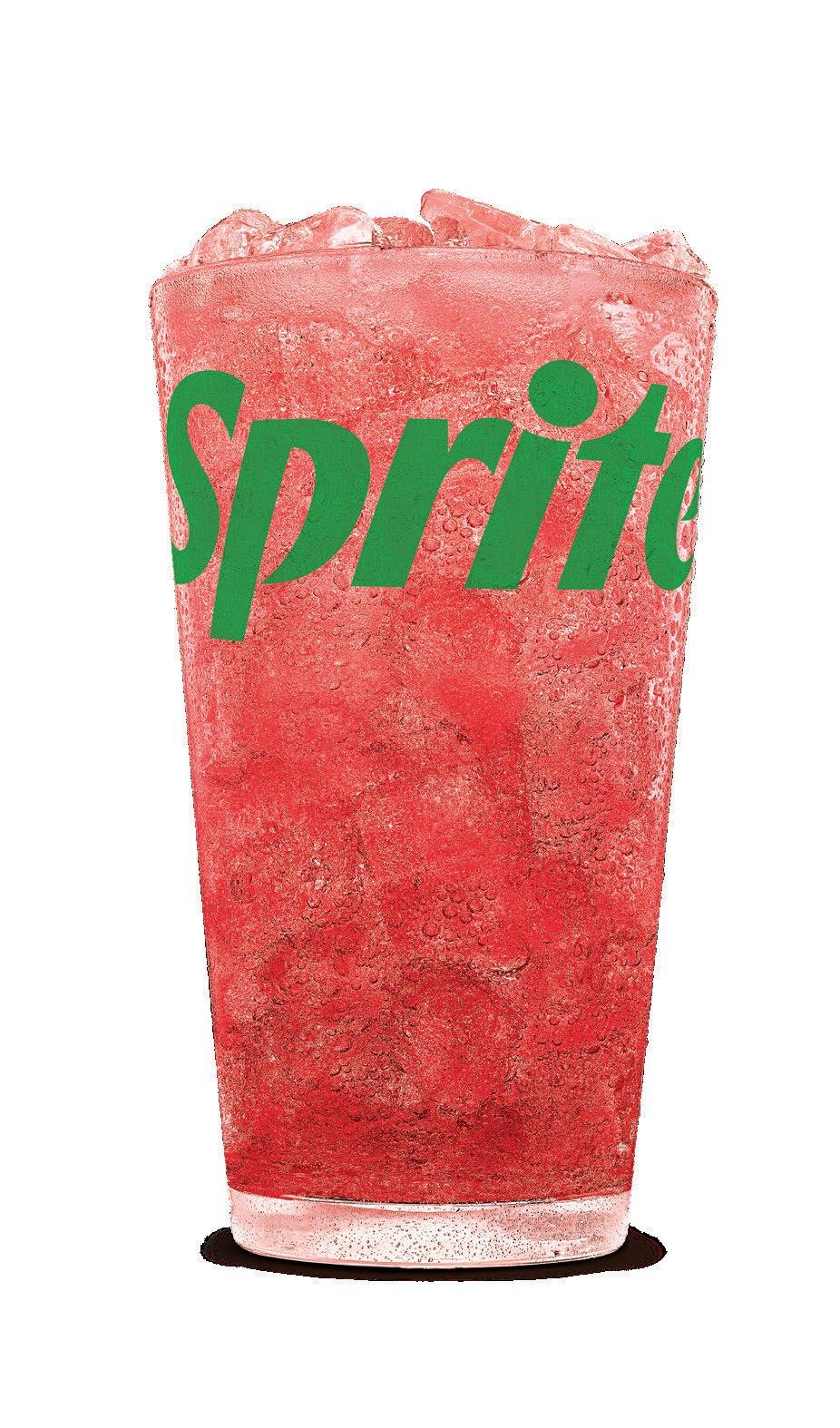
Company Name: LEPSCO Inc.
Partner(s): Paul Scordia, until May 2024.
Year You Became a BK® Franchisee: 2005
Number of Restaurants: 11
State(s) Your Restaurants Operate In: Ohio
How did you become a BK® franchisee?
BURGER KING® was actually my first job in high school. After working my way up from employee to assistant manager, restaurant manager and then district manager, I set a goal that someday I would be an owner. I loved the job, the people and the brand, and I had a passion for it. I knew then, ultimately, that my life’s dream was to own the business, not just to work in it.
If you have business partners, how did you meet?
Paul Scordia was my business partner, and he just retired this May. We were partners for almost 20 years and worked together for a little over 30 years total. He gave me the opportunity to grow in the BK brand and end up where I am today. To say that I am grateful is an understatement.
In your opinion, what stands out about the BURGER KING brand?
I believe there are two distinguishing qualities of the BURGER KING brand:
1) Flame broiling. It sets us apart from every other fast-food concept out there; it’s iconic and it’s who we are.
2) The franchisees. The franchise community is incredible and full of tremendous people with a passion for the brand. They are the driving force behind the success and longevity of the BK system.
Going forward, what are your top three business goals for your company?
1) The goal I am the most excited about is creating growth opportunities for my key employees. Having had that opportunity early in my career, I want that for those who are ambitious.

The franchise community is incredible and full of tremendous people with a passion for the brand.
Nothing gives me more satisfaction than to see someone rise through the ranks and better themselves and, in turn, their families.
2) Like every franchisee, I want to continue to increase the financial health of the business.
3) I’m stating this last, but it has to happen first. Outstanding operations. We have to strive to always be better. Outstanding operations make the other goals possible; it gives you opportunities for business growth and therefore opportunities for your employees’ growth.
What is the best piece of business advice you have received?
While not specific to just business, more a general life advice that I got from my father many years ago that I have applied to my business, and it’s simple but very powerful: Never give up. Often it is not always about being the best or most talented at a specific thing. Sometimes you win just by being the guy or girl who was willing to do what other people wouldn’t.


What do you feel is the biggest challenge currently facing franchisees?
At any given point in time, there are always the usual suspects — commodity costs, labor pressures, competition. I think a big challenge now is technology and using it right. I would even say that we should look at this as an opportunity. If we can become the leaders in digital, delivery and leverage artificial intelligence, I think we win. Our industry is evolving at a rapid pace, and I think there’s a great reward for those who get technology right. Our brand needs to be poised to do that.
What is the biggest industry change since you started?
I have to say technology again. So much of our restaurants are digital. From timer placards to timer bars, cook-out papers to tablets. Cash used to be king, and now most of our transactions are digital. We went from full dining rooms to transacting more via delivery that was ordered on a phone. Technology is changing our interface with the world.
Tell us about your family.
I’m married to a wonderful woman named Melissa and I’m father to Aidan, who is 15. We live in Troy, Ohio, with our yellow labrador and German shepherd.
Tell us about your personal interests.
I enjoy golf, bourbon and building furniture.
Complete this sentence. If I weren’t a franchisee, I would be … a fighter pilot or an aeronautical engineer. n






1
ook, Listen, Read is a quarterly compilation of some of the most highly rated and reviewed apps, podcasts, books, websites and other resources. National Franchisee Association does not support or endorse the use of these tools, which merely serve as a guide to exploring a new level of knowledge and productivity for your business.

If you’ve ever wondered why some businesses thrive more than others, ”Start With Why: How Great Leaders Inspire Everyone to Take Action” reveals an essential quality within influential leaders: purpose. “Start With Why” encourages business owners and managers to stay true to their goals as leaders to keep their enterprises on track and reminds readers to focus on what’s most important to them and why they started businesses in the first place.


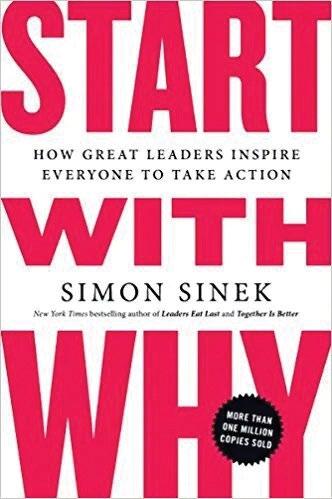
2

This is not a book about business strategy — strategies change like the seasons. This is a book about something much more permanent. ”The Diary of a CEO: Discover the 33 Laws of Business & Life” is a runaway No.1 bestseller by Steven Bartlett: entrepreneur, podcaster and Dragon’s Den star. Building on the success of the eponymous No. 1 podcast, where Bartlett engages with some of the world’s most influential people, experts and thinkers, the book embarks on a curiosity-driven journey to uncover untold truths, unlearned lessons and important insights designed to make life more enjoyable, successful and fulfilling.


3

Clockify is a time tracker that allows users to track the time spent on projects and analyze productivity. It can be used on the web, desktop and mobile, with all tracked data synced in real time, enabling seamless switching between devices.
4

Whether a franchisee, part of a large franchise operation with multiple locations or managing a single location, Ron Pagliarulo shares valuable insights in ”Best of the Best: Secrets To Becoming a Top Revenue Producing Franchise Operations Manager” that can help elevate performance in the field. Each franchise system comes with its own complexities and challenges. While it’s not an easy business, it can become simpler with an understanding of the keys and secrets that make a great franchise operations manager.

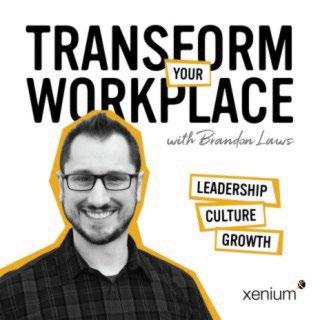

8 Transform Your Workplace, renowned as a top-rated HR and leadership podcast, covers into all aspects necessary for creating an outstanding workplace. It features a diverse lineup of industry experts, authors, speakers, HR professionals and entrepreneurs worldwide who share their insights and big ideas for organizational transformation. Every week, the podcast explores a fresh topic, encompassing various subjects such as human resources, effective communication, cultural development, personal and business growth, leadership and the latest workplace trends, such as A.I.


5

10 Minute MBA — Daily Actionable Business Lessons With Scott D. Clary is a daily podcast hosted by Scott D. Clary himself, an investor and CEO. Although the title may be long, we were impressed that each installment of this podcast is incredibly short, averaging just 10 minutes or less. These bite-sized episodes provide actionable insights, tools and strategies you can use to start or grow your business today.

7

6

Notion is a single space for thinking, writing and planning. It allows for capturing thoughts, managing projects or even running an entire company, all in a highly customizable way.

Mark Cuban, one of the world’s wealthiest and most influential businessmen, collects his greatest lessons on what it takes to become a thriving entrepreneur and compiles them into ”How to Win at the Sport of Business: If I Can Do It, You Can Do It.” Drawing upon his profound insider knowledge, Cuban offers unconventional business tips and tells his stunning rags-to-riches tale from selling powdered milk and sleeping on friends’ couches to owning his own company and becoming a multibillion-dollar success story. Mark shows how he puts his own advice into practice and how entrepreneurs at any stage of their careers can outmaneuver their competitors.
9

Eye On Franchising is a top 50 podcast that is all about franchising. It assists first-time or fifth-time entrepreneurs with every aspect of the search process. Lance Graulich is the founder and CEO of ION Franchising, an industry-leading franchise consulting and development company representing over 700 franchise brands & business opportunities in every imaginable category. Whether you were born an entrepreneur or are willing to learn to become one, you are in the right place. n






1
In the U.S., an estimated 30-40% of the food supply goes to waste, amounting to roughly 133 billion pounds of waste and $161 billion in lost value. Restaurants, grocery stores and foodservice companies contribute to 40% of this waste. Given foodservice is a comparatively wasteful industry, business owners need to minimize waste while providing fresh product to their customers.
2 The finite supply of fossil fuels and the emissions restaurants cause are the catalysts of an innovative industry: alternative fuels. Many companies are dedicated to buying restaurant food waste and converting it to biofuels as a cleaner energy source. Not only is it more efficient, it mitigates food waste from landfills, which causes the emissions of 37 million cars.
3 Converting restaurants to solar power can reduce energy costs. In addition, dependent on location, the government provides incentives for utilizing green electricity with tax credits and rebates. Twenty-five percent ROI can be realized when incentives are applied to reduce the total cost of installation.
4 Technology can be implemented into restaurants to monitor and control security, air conditioning and more to prevent overconsumption and notify the business owner if a situation arises. Restaurants that have implemented modern technology reported increased efficiency (77%), less pressure on staff (61%), reduced costs (35%) and more revenue (33%)
5 Supplementally, artificial intelligence has been developed in recent years to accommodate restaurant operations and smooth operations. Forty-four percent of companies that implemented this technology reported cost savings.
6
Maintaining inventory maintains the bottom line. Operators who do a weekly inventory turnover calculation can add between 2-10% to it.
7 Using simple tactics, such as FIFO (first in, first out), can reduce food waste and inventory expenses. After all, inventory can account for 70% of a company’s expenses.
8 Putting your efforts into retaining guests versus gathering new ones can be a profitable venture considering that restaurants lose an average of 30-40% of their best customers per year.
9 Identifying disengaged employees can save your company in wasted labor costs. U.S. companies pay around $475 billion for employee disengagement each year.
10
To roll with the changing restaurant landscape, operators may want to consider changing processes and/or daily operations to save time, money and improve employee morale. Around 38% of operators trying to make this shift want to save more time.
Sources: apicbase, First Energy Systems, Incentivio, Kirsch CPA Group, Oberlo, nbbj, Restaurant Technology News, The Growth Hacker’s Gazette and Skip Shapiro


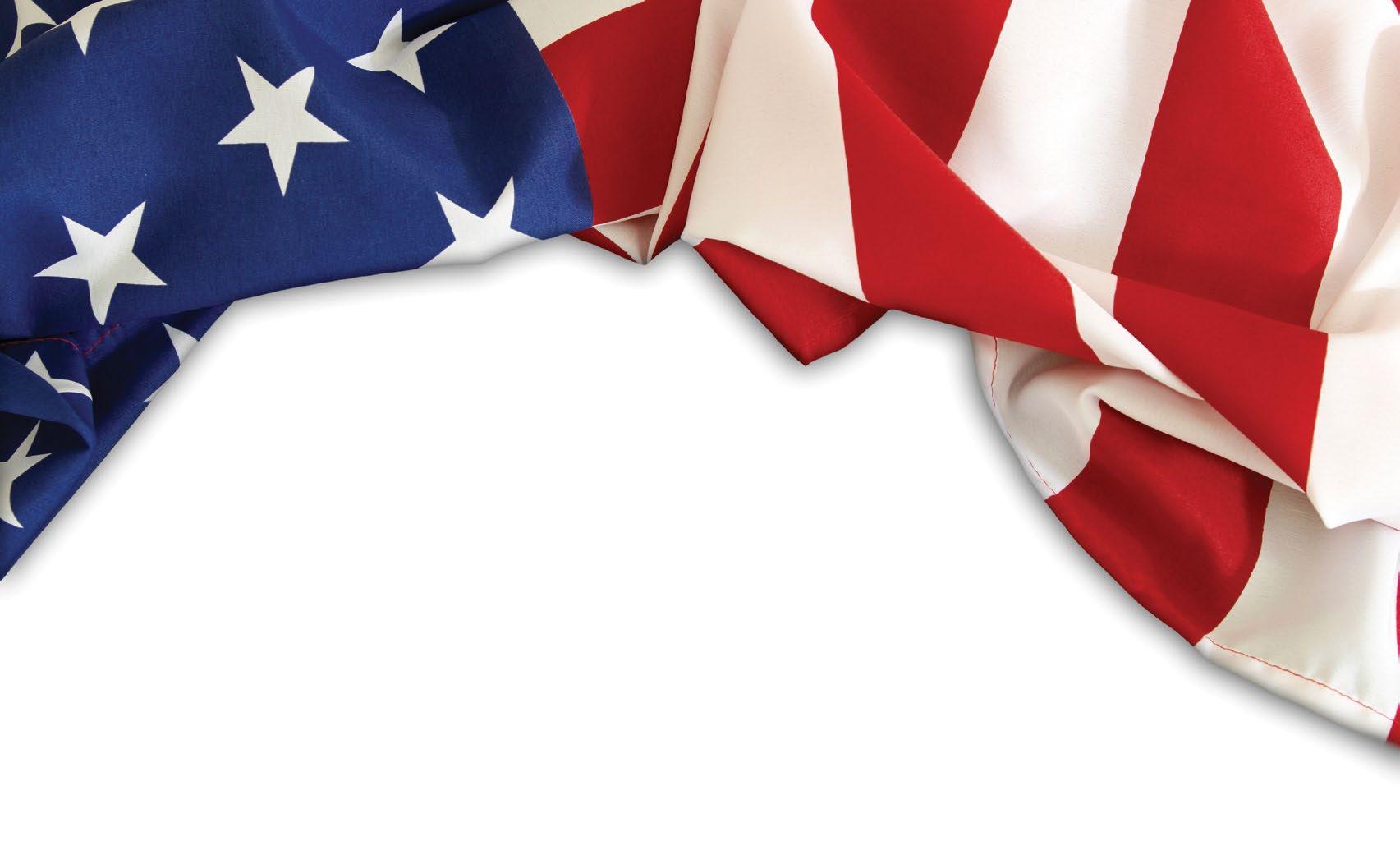
QWhat skills or perspectives from your background do you apply as a public official?
AI got my start in small business from behind the counter of McDonald’s when I was 16 years old. After climbing the ranks, I enjoyed a career working for our franchisor in middle management. I now own McDonald’s restaurants where I personally experience the difficulty of operating a business. I’ve also served on the board of directors for a community bank, and I’ve started two real estate investment companies and a self-storage company. All these real-life experiences and recognizing the struggles and the rewards give me a perspective in Congress that is clearly missing on Capitol Hill.
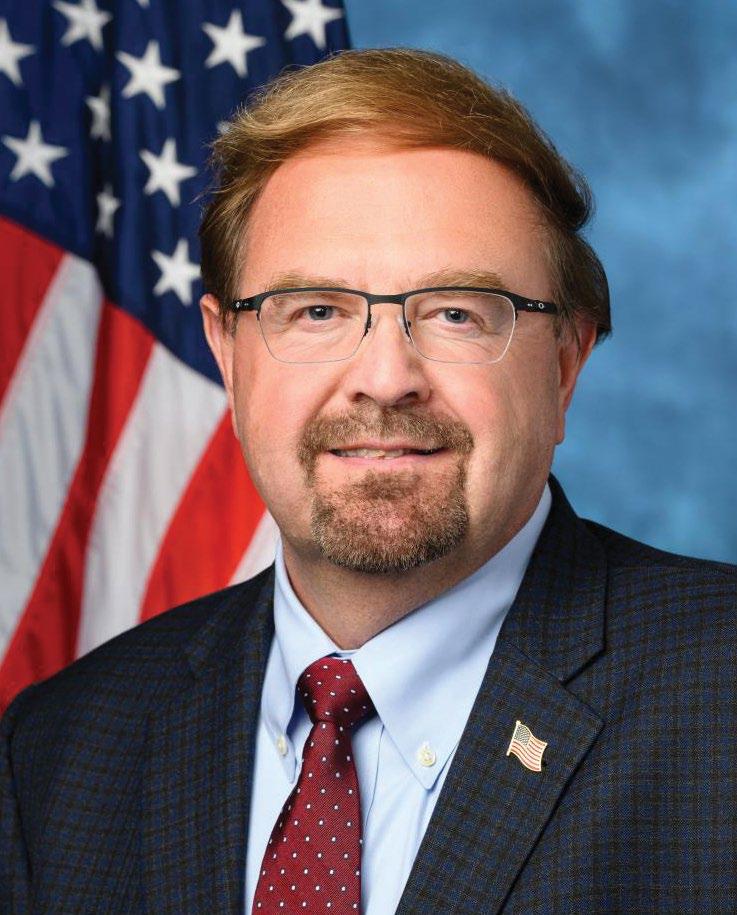
Q What do you see as the current biggest threat to small-business owners?
AThe most pressing tax issue is to extend the Tax Cuts and Jobs Act that is set to expire next year. This critical tax policy, among other things, allows a 20% deduction for small-business entities and allows accelerated depreciation. Regulation can best be kept in check with bills like the REINS Act, the Ensuring Accountability in Agency Rulemaking Act and the Ensuring Accountability in Agency Rulemaking Act, as well as the Show Me the Science Act that I wrote. Of course, there is a constant stream of agency rules that need to be quashed.
Q What challenges have you helped small businesses in your district overcome?
A From fighting against government overregulation to helping small-businesses owners address issues with federal agencies through casework – such as with the IRS for employer retention credit and refunds – it has been rewarding to use my life experience and business acumen to make a difference in the lives of the common people of western North Carolina and nationwide.
Q In what ways are you seeking feedback from small businesses in your state/district and using that information in Washington, D.C.?
AI block one day a month where anyone living in my district can come “Chat with Chuck” to discuss anything on their mind. Also, quarterly, I host a “Chamber Chat” where any member of a Chamber of Commerce in my district can join me on a Zoom call to hear an update on matters of interest to business people and to ask questions and give input. Please call my office at (202) 225-6401 to schedule or listen to a chat. I also hear from small-business owners throughout our district, whether it be in person or concerns they raise at my telephone town halls. One issue I’ve heard over and over again from small-business owners is not being able to find the workforce to fill open positions. Congress must incentivize our citizens to work, not to avoid work. We need more work requirements and solid unemployment reforms. For example, I’m the author of the Unemployment Integrity Act that would require unemployment claimants to show up for job interviews.
Q What seat do you believe franchisees have at the table and what do you do to support them?
AMy district’s economy – and economies across our nation – is driven primarily by small businesses, and the franchise model offers opportunities that many of us would not realize otherwise. To keep the American Dream attainable and for the U.S. to stay in the forefront of the global economy, Congress must produce policies that allow small businesses to thrive and create jobs.
Q What message do you have for small-business owners struggling with supply chain issues, inflation, staffing and other prevalent issues of today’s day and age?
A Stay engaged with your elected leaders so we fully understand the issues affecting small businesses and the pain they are experiencing. Small businesses are the backbone of America, and our risk-takers and job creators have long been under attack by Washington. Like I did while serving in the North Carolina state Senate, I will continue to strive to reduce regulations, create a better tax climate and help develop a workforce that provides opportunity and fuels our economy. n


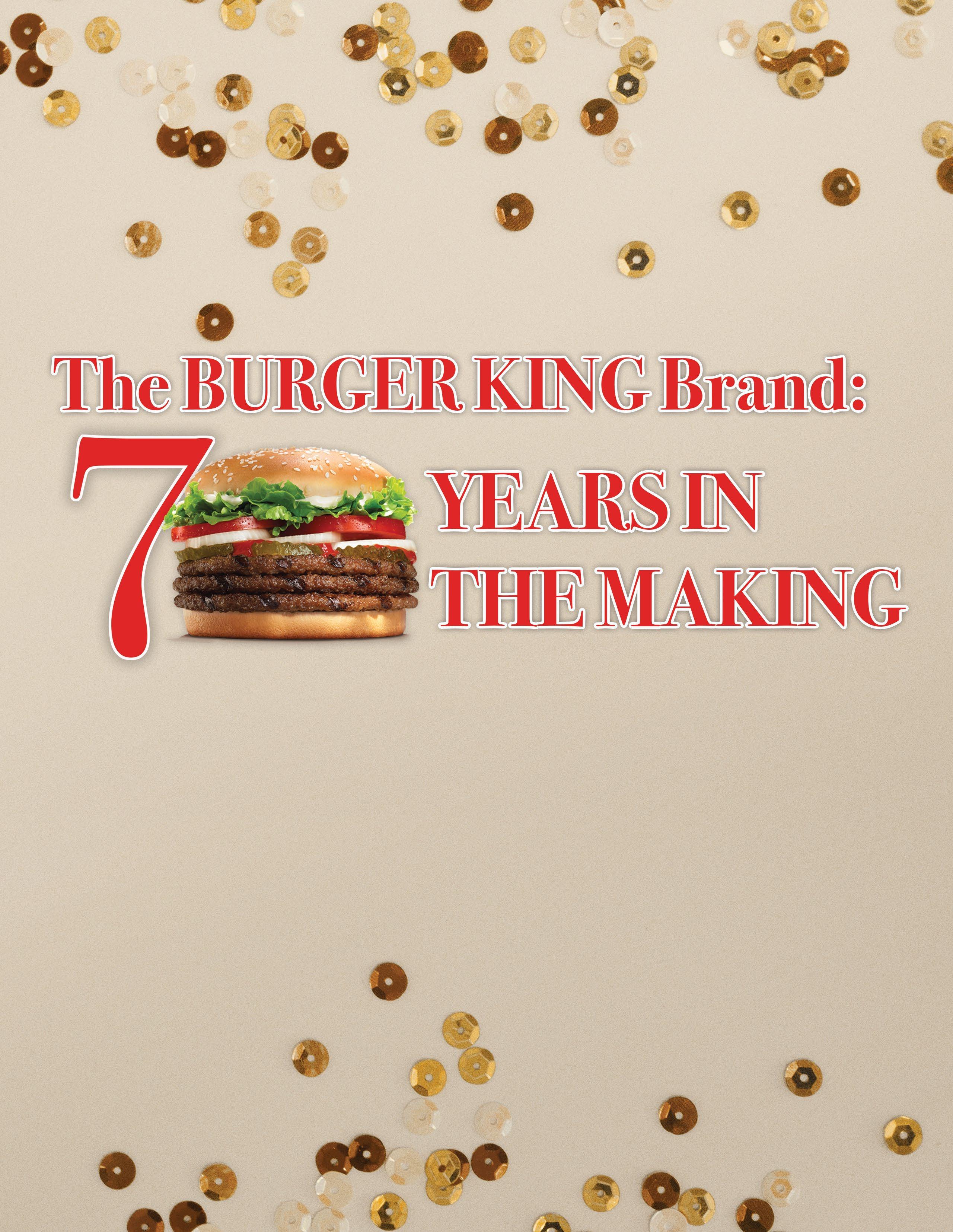

In 1959, a small burger business originating in Jacksonville, Florida, was purchased by David Edgerton and James McLamore, two American entrepreneurs who would name the business BURGER KING® and begin building a legacy of customer satisfaction, exemplary foodservice and excellence in quality. An iconic American brand, BURGER KING has grown over several decades into a business that is representative of the entrepreneurial spirit that flows through so many of the nation’s citizens, as well as a passion for community and public service. What began as a small-business venture in one state is now a globally-recognized and beloved brand, and its history continues to impact the BURGER KING stores of today.
As BURGER KING franchisees, it is important to know some of the history of the brand, because so much of the history is shaped by the franchisee community. Just as customers and corporate employees can have a lasting impact on the overall reputation of the BURGER KING brand and the way it operates, every single store is owned by a person who, at some point in their lives, decided that they wanted to take on the task of owning a BURGER KING business. Franchisees come from all walks of life and unite under a common purpose: to operate their businesses to the best of their ability and always strive for success.

2000’s

As BURGER KING reaches its 70th birthday, it is worthwhile to dive back into its history and observe all that has changed about the brand, from the menu items that the brand has crafted to some of the different ways the brand has advertised its strengths. Over the years, it is only natural that a brand would cycle through various logos, location exterior and interior designs, menu
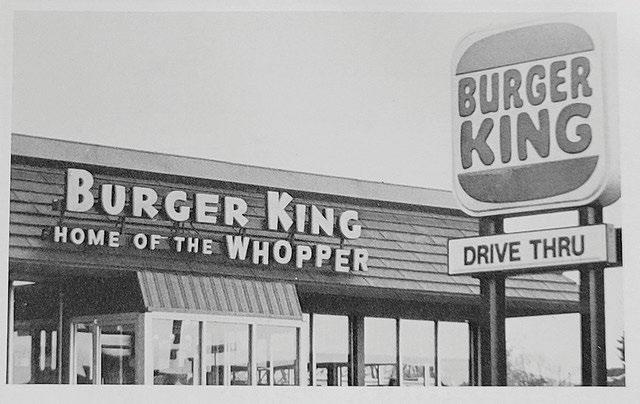

1950’s

1990’s
promotions, etc. What marks the persistence and strength of a brand is its ability to go through such transformations, all while maintaining an identity that the public can continue to recognize and identify with.
From its early days, BURGER KING has been known for innovation. In 1957, the company introduced The WHOPPER®, a burger that set the standard for the QSR industry. This focus on offering something unique and different can inspire franchisees to continually innovate within their own stores. Whether it’s through new menu items, creative marketing strategies, or enhancing the customer experience, franchisees can use this legacy of innovation as a blueprint for staying ahead of competitors.
Franchisees, just like the BURGER KING brand, are no strangers to innovation. The act of preparing one’s locations to be a part of a grander network of restaurants requires just as much creativity as it requires an element of uniformity. While it is important for franchisees’ businesses to align with the brand’s overall identity, a franchisee’s store can always be a reflection of them and their goals as an individual and a business owner. If you’d like your BURGER KING location to be a place where members of your community feel inclined to come together to share meals, celebrate accomplishments, network, create lasting relationships, etc., one has to be innovative in order to create a welcoming space for customers. BURGER KING, as a brand, has created a platform for its franchisees to be innovative business owners who
Continued on page 20


70 Years
Continued from page 19
know that their individual contributions to the overall landscape of the brand are fundamental to its reputation and global recognition.
BURGER KING’s famous “Have It Your Way” slogan, introduced in 1974, was a game-changer in the QSR industry. It emphasized customization and customer satisfaction, allowing customers to tailor their meals exactly to their liking. This philosophy can still be a powerful tool for franchisees. By focusing on customer preferences and offering a personalized experience, franchisees can build loyalty and differentiate themselves in a crowded market. Encouraging staff to embrace this mindset can lead to improved customer service and higher satisfaction rates. While customization has become more common in the industry today, BURGER KING was one of the pioneers of this approach, and it remains a cornerstone of the brand’s operations. As a brand that has now reached its 70th birthday, it is essential that the values it was founded on continue to permeate in customers’ minds today. Franchisees can consider the ways they have been and continue to embody this iconic slogan within their everyday operations. Consider whether customers are entering your locations and feeling as though their needs and desires are being heard and understood, as they have been for decades. As a franchisee of the brand, it is also imperative that you feel YOU are able to “Have It Your Way” when it counts the most. National Franchisee Association (NFA) is an association built upon BURGER KING franchisees coming together to be heard, to have their needs as business owners advocated for and to share best practices with one another. NFA continues to evolve

and delve further into its members’ core values, alongside the iconic brand that has brought all members together. Even at 70 years of age, a brand can only be expected to continue to change and grow and mold itself into an entity that best serves the customers of its time. BURGER KING, as a brand that has gone through several evolutions since its conception in the 1950s, is a prime example of a brand having what it takes to remain a staple in the landscape of American foodservice. As franchisees of the brand, being aware of how BURGER KING has changed throughout its history can inform the way that the business can be approached from an owners’ standpoint; there are countless opportunities for individual locations to change and evolve for the better so that they can best represent the current identity and reputation of BURGER KING. Whether this entails being open to more community-centered events at one’s locations, ensuring that the staff being hired are aligning well with BURGER KING’s mission to serve and satisfy customers or making the decision to take on a remodel, a BURGER KING franchisee has the potential to impact how others interact with the brand every day. It is up to the franchisee to ensure that their actions work for the betterment of not only their own business, but for the brand overall and the experiences customers and staff create with BURGER KING. For years, Flame has tasked NFA members with sharing some of the details of their history with the BURGER KING brand, in an effort to place a spotlight on the franchisees at the center of the business. Through all of the answers gathered, it has become clear that there are a few things about the BURGER KING brand that have impacted BK owners throughout its long history and continue to have an impact.

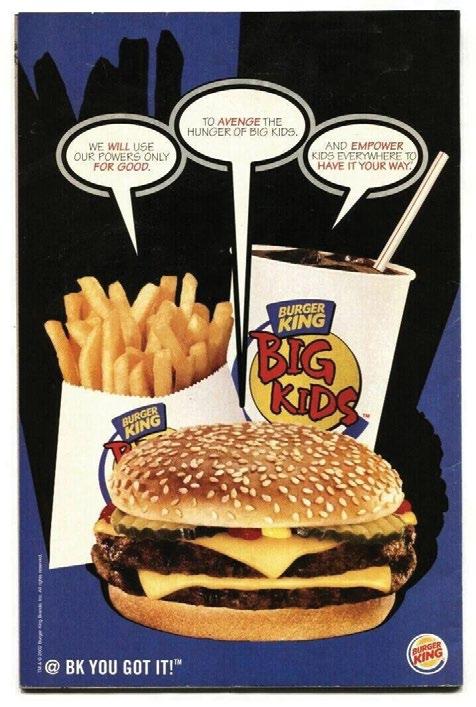



Flame, 1994 Winter Issue
For some NFA members, what stands out to them the most about BURGER KING is the product. Many have expressed that they feel nothing in the industry compares to the quality of the burgers that come from BK®’s flame broiling method. Some have explained that, in owning a BURGER KING business, one is always learning how to best connect with the people in their community. Others

say that what has carried them through the years of being a part the brand is the opportunity to work with their staff and business partners. Through the NFA community, one can find countless versions of the same story unfolding: Dedicated individuals across the nation have, at one point or another, found their way to the BURGER KING brand in search of an opportunity to own and manage a business that not only promises success, but professional and personal growth. Flame thanks NFA members and franchisees everywhere for sharing your reflections and reaffirming the uniqueness of both the BURGER KING brand and the people behind it.
Here’s to 70 years of an iconic American brand that continues to inspire entrepreneurs to enter the QSR industry and satisfies hungry customers across the globe! The franchisees everywhere that continue to keep the spirit of the brand alive and well within their communities are also to be celebrated for years to come. n Hi-Temp (E-UHT) and Low-Temp (E-ULT) Options— Specifically Designed for QSR Applications.










History Behind the Industry is a spotlight on events and/or figures that have shaped or significantly impacted the current state of the quick-service restaurant (QSR) industry, and how BURGER KING® franchisees can utilize such information for the betterment of their businesses.
Flame Broiler Finds Its Way Into BURGER KING Kitchens…
When BURGER KING was first introduced to Jacksonville, Florida, in the 1950s (then called Insta-Burger King), there was a device in the kitchen that brought the restaurant’s concept together: the Insta-Broiler. The device was hailed for its efficiency in cooking a large amount of burgers and simultaneously heating buns, but the design wasn’t entirely faultless. The Insta-Broiler’s quick degradation pushed BURGER KING to introduce a device we now all know very well: the flame broiler, which cooks burgers over an open flame. This technique is made to enhance the burger’s smoky, char-grilled taste and create a satisfying texture with slightly crispy edges and juicy interiors, making each bite flavorful. Flame broiling, now a signature of BURGER KING, exemplifies the brand’s commitment to delivering a unique burger experience to rival competitors for years to come.

The Industry Today… For BK® franchisees, what seems like a simple fact about the history of BURGER KING’s brand and operations can actually be a source of inspiration to think about what factors make their own restaurants stand out. Just as it was important for the founders of the brand to figure out how the experiences they offer their customers can be unique and competitive in the industry, it is important for franchisees to consider how they can pinpoint what is most unique about their locations and capitalize off those qualities. Every BURGER KING has the potential to give customers uniquely enjoyable and satisfactory products and experiences — and the ideas that first come to franchisees’ minds may not always be what ends up sticking around and generating growth in the long run. The flame-broiler came to the BURGER KING brand through both innovation and trial-and-error; franchisees should take this piece of industry history as a sign that there is always something unique and valuable to be found in their businesses, and they just have to be willing to go searching for it. n







In today’s fast-paced world, quick-service restaurants (QSRs) face heightened expectations from consumers who value not only speed but also convenience and quality. The past few years in the restaurant industry have been molded around business owners’ efforts to gain what they might have lost in 2021 and beyond: profitability and foot traffic. What might help franchisees face industry challenges could be a resurgence of one of the values that brands like BURGER KING® were founded on: giving the customer what they want, and then some. Modern consumers seek more than just a quick meal; they want a seamless, personalized experience that fits effortlessly into their busy lives. For franchise owners, this presents both a challenge and an opportunity: to leverage technology and refine operational strategies to meet evolving customer needs. Embracing these changes and prioritizing customer satisfaction through innovative solutions and dedicated staff can transform a typical QSR visit into a standout experience, fostering loyalty and driving long-term success.
The evolving landscape of quick-service restaurants demands more than just speed; it calls for a nuanced approach to customer satisfaction and operational excellence.
When working to improve customer’s experiences in their restaurants, franchisees should remember that what makes an establishment a special place to many customers is the feeling that they and their needs are known and seen. Every QSR has its own story, as do the customers who walk through their doors every single day. Making efforts to show customers that their lives both inside and outside the restaurant matter, not only to restaurant staff but to franchise owners, has the potential to transform a typical customer experience into one that is especially welcoming and satisfactory. Franchisees could benefit from prioritizing the kinds of events that cause a community to grow around a restaurant — a community where people know each other’s names, remember their favorite orders, and ask how their families are doing. An event that brings people together, such as a fundraiser, a staff anniversary or a business milestone celebration, could be one of the first steps to creating an atmosphere within a franchise that encourages customers to view it as more than just a place to pick up their lunch. That location can become a place to greet new friends, receive more personalized service and go home with not only a meal to sustain them, but a sense of importance. Letting customers know just how important they are to an establishment will undoubtedly improve their experiences, which can ultimately bolster the overall success of the business.

by TYLER RYAN
It goes without saying that the main appeal to quick-service restaurants for most consumers is the promise of what they’re named for: quick service! It’s been established time and time again that the restaurant industry is poised to be altered dramatically by the implications of the COVID-19 pandemic and the subsequent boom in online ordering and delivery services. Today's customer is even more inclined to seek fast, quality results through minimum effort than the customers of past decades. Our daily lives are intertwined with technological advances that have made countless processes and tasks easier to complete in less and less time. People are more likely than ever to expect a certain level of convenience when they visit their favorite QSRs, and there are ways to ensure that franchisees are actively working to not only meet customers' expectations, but to use the tools at their disposal to go above and beyond. There are several ways a franchise owner can go about ensuring that a lack of convenience does not spoil a customer's overall experience in their establishment, including:
• Embracing more of the technology that has begun to help restaurants everywhere streamline the ordering process, such as kiosks, AI-operated Drive-thru’s, third-party delivery app partnerships and more. Learning how to function best alongside some of the new technologies being introduced to franchises across the country is essential to keeping restaurant operations running smoothly.
• Ensuring that enough energy is being dedicated to training restaurant staff to work together to maximize efficiency and speed. Training efforts will always be a cornerstone to keeping a restaurant operating to customers’ standards.
Knowing how to best utilize your unique staff is another key piece of improving customer experiences within a franchise. In every restaurant, keeping operations going smoothly is dependent on the staff working together and understanding how to bring out the best performance in one another. As a franchise owner, getting to know and understand the people you're hiring and training to support your restaurant day-in and day-out can only help to improve overall efficiency and positivity in the restaurant environment. If the staff of a franchise is operating at their best, they're more able to create experiences for customers that can exceed expectations. In order to maintain the kind of customer experience that not only sustains a franchise but promotes growth, franchisees could consider dedicating more time to not only ensuring their staff are trained, but ensuring that their staff are known, appreciated and working in the best position possible to do their jobs effectively.
The evolving landscape of quick-service restaurants demands more than just speed; it calls for a nuanced approach to customer satisfaction and operational excellence. Franchisees can meet and exceed the heightened expectations of today’s consumers by creating a welcoming atmosphere that values each customer and their unique experiences. Ultimately, the success of a franchise can hinge on balancing efficiency with personalized, meaningful interactions, ensuring that each visit to a QSR is not just a transaction but an opportunity to build lasting relationships. By focusing on these elements, franchisees can transform their establishments into cherished local hubs that customers look forward to visiting time and time again. n
TYLER RYAN is the communications editor for NFA. You may reach Ryan at 678-439-2300 or tylerr@elevanta.com.





In this time of rapid change on business, technological and consumer fronts, one thing has remained a constant: person-to-person customer interactions matter. Getting these personal interactions right is critical for engaging with any customer in any industry.
It has also remained true, but is worth repeating, that excellent customer service and experience enhance customer satisfaction and loyalty, increase repeat business and word-of-mouth and yield a higher Net Promoter Score (NPS). All of that drives better performance, whether revenue, growth, profit, market share or other measures.
Most leaders striving to improve their customer experience focus solely on what the organization must DO differently. They map out the customer journey and think about how to change a process or behavior to improve all or part of the experience.
Our decades of work helping leaders shape both customer and employee experience suggest that’s the wrong place to start. Great customer service starts with a mindset: how you and your people think about the work they do and the customers they serve. When mindsets change, the right behaviors naturally follow, which leads to a better customer experience and all of the benefits that accompany it.
We should, therefore, start there. As we focus on shifting mindsets, consider the following:
• A collection of mindsets is what makes up an organization’s culture — it’s about creating a culture of excellent customer experience.
in action: A restaurant chain had been receiving numerous customer complaints of rudeness, both at the crew and managerial levels. While reflecting on their approach to their restaurants, corporate managers realized that during their on-site visits they were focused only on what was wrong with each restaurant. This was unintentionally motivating the restaurant managers and ultimately the crew to ask the same question of the customers: “What’s wrong with them?” How the managers treated the crew during and before the visits influenced how the crew treated customers. Realizing the impact of their negative shadow, the corporate managers returned to stores with an appreciation mindset, first sincerely calling out things the crew was doing well, then together finding ways to improve. That motivated the crew to appreciate customers and enhance how they served them. The sincere appreciation created more rapport and opened up the restaurant team to
• Employee experience = customer experience; unhappy employees = unhappy customers and, conversely, happier employees = happier customers (as our examples will illustrate).
• Culture starts at the top — the entire organization is strongly influenced by the “shadow of leadership,” so unless leaders have the right mindsets, it will be difficult if not impossible to deliver excellent customer experience. Shaping a customer-focused culture from the top-down is as important as any strategic initiative.
When looking at the difference between clients who were successful at driving large-scale change and those who weren’t, the No. 1 characteristic of successful changes: they were leader-led. A wealth of evidence from our consulting work and other sources suggests the first principle of successful culture change is purposeful, leader-led change.
As leaders focus more intently on creating a stronger customer-focused mindset in their teams and the organization, it won’t suffice to think, “How can I create a customer mindset in them?” One first must ask, “What can I do to develop a stronger customer mindset myself?”
To that end, we share five key mindsets that ensure great customer experience for your reflection and consideration.
receiving constructive feedback, when appropriate, to coach them on ways they could serve the customers more effectively. Service improved and complaints declined dramatically.
Key point: A dual mindset of appreciation for employees and customers alike is critical.
Questions to ask:
• Am I clear that customers and employees are my top priority? Do I appreciate that they both keep us in business?
• How clearly and consistently am I communicating my appreciation to my team, both verbally and through my actions?
Continued on page 28
Mindset
Continued from page 28
Mindset in action: A nurse at a major medical center visited an elderly female patient’s room on her usual rounds. She was busy checking and recording the patient’s vitals on the various machines when she heard a timid voice. “Am I okay? No one has told me anything,” the patient next to her in the bed said, near tears.
The nurse, who had recently completed a workshop on being present, realized that she was narrowly focusing on the patient’s medical details, but was overlooking the patient herself. She sat with the patient, answered her questions and reassured her about the process and the road ahead. Within minutes the patient was visibly relaxed; she thanked the nurse and asked her to try to come back often.
Key point: “Being here now” with customers and employees shows you understand and value them. Listening while being fully present and seeking to understand rather than quickly respond is the highest level of listening and an approach that helps you address others’ needs most fully. Embracing this mindset enables you to shift from focusing on the process to the person.
Questions to ask:
• Am I fully present with those around me, including our customers? Does it seem like they really feel heard and understood?
• What are typical distracting thoughts that might pull me out of the moment with others?
Mindset in action: A hospital custodian, while polishing a hallway floor, noticed a distraught-looking couple. Normally, he would have not paid attention and continued the task at hand, but had recently attended a workshop that stressed the importance of personal accountability. Realizing that he, too, could impact and serve their customers, he approached them and discovered they had just learned their teenage daughter had late-stage cancer. “How can I help?” he asked. The couple spoke of their reliance on faith, and the custodian offered to pray with them. The custodian led them to a quiet corner of the hospital and spoke a brief prayer for


the couple’s daughter. Touched by this, the family wrote a letter to the hospital’s CEO, describing their experience and thanking her for having “such caring staff.” When everyone at all levels in an organization has an accountability-focused customer mindset, it impacts how service-oriented those interacting more directly with customers can be, boosting satisfaction significantly. It even broadens employees’ focus for those who might not immediately see how they impact your customers to finding ways to do so.
Key point: Accountability is a mindset in which we continually ask ourselves,
“What more can I/we do to get the desired result?” The goal is to move from powerless thinking (unaware, blaming, focusing on excuses, waiting and hoping things will change) to powerful thinking (acknowledging reality, identifying what piece you can own, finding solutions and moving forward). The optimal combination is to instill an accountability mindset in employees and empower them to make a difference for customers.
Questions to ask:
• What more can I/we do to help our customers?
• How can I/we empower the frontline more fully to meet customer needs?
Mindset in action: A key senior leader in retail was known for his temper — “chewing out” people when things went wrong and often firing them on the spot. After a multimillion-dollar women’s apparel launch failed, those in charge cowered in a conference room, fearing the leader’s wrath and wondering who wouldn’t be there the next day. They didn’t know the leader had recently been coached on embracing a curiosity mindset. When the leader arrived, there was no outburst of anger. Instead, he said, “Let’s figure out what happened.” Together they discovered the issue was not with the product but the customer service surrounding it: The new products fit differently than previous lines, and store associates hadn’t been sufficiently trained to help customers find their size. Some basic training and clarity in communication helped the new line become one of their most successful ones. Bringing a curious mindset — and listening — had made all the difference.
Key point: When someone brings up a new idea or does something we may not understand, we have a choice to respond from a place of curiosity or judgment. There is deep value in assuming positive intent in others. Coming from curiosity creates a growth mindset marked by an openness to change and a willingness to learn and try something new. Our moods and energy levels affect how we show up, so we need to aim to lead with curiosity and openness whenever possible.
Mindset in action: There is a legendary, true story of Nordstrom’s customer service. One of their associates was surprised when a customer rolled a pair of tires into the store and said, “I bought these here and would like a refund.” The problem: the store didn’t sell tires. But some years before, Nordstrom had acquired a small chain that did, reducing the inventory from those stores to apparel and shoes. Rather than turn the customer away, the associate called a tire company to get a sense of the price, and then “refunded” the customer an amount based on that. Hearing the story, senior management posted it in stores to praise the creative associate and remind others of the need to prioritize customer service. Choosing customer experience over the bottom line, while increasing return-related shrink, has helped the retailer cement its renowned service reputation and ultimately boost profits.
Key point: Many organizations face too many strategic initiatives, making it hard to focus on what matters most, including customer experience. Tactical, day-to-day procedures get in the way, which isn’t good for employees or customers alike. The goal is to simplify and focus on what is ultimately the most important — “big rocks” or blue-chip those processes, training, reinforcement and mindsets that impact the customer and drive the best possible customer experience.
Questions to ask:
• What priorities will help us maximize the value of the customer experience we deliver?
• Of all our communications to our stores/sites/business units, what percent of them focus on the customer experience (vs. products, promotions, sales, etc.)? Can we boost this proportion?
Questions to ask:
• I wonder why that made sense to them? How can I learn more about this situation and/or their motivation or thinking?
• Am I, through genuine curiosity, creating a psychologically safe environment where employees can learn and explore how to create an enhanced customer experience?
Through a deliberate focus on one’s own leadership shadow, the creation of a positive environment where all employees can operate at their best to serve valued customers, and with training and reinforcement through ongoing appreciative and constructive coaching, leaders can instill mindsets throughout their organization that will improve the customer experience and lead to overall better business results. n
HEIDRICK & STRUGGLES is the premier provider of executive search, corporate culture and leadership consulting services. John McKay and Teresa Garza with Heidrick & Struggles delivered a series of interactive educational workshops at the 2024 National Franchisee Association (NFA) Leadership, Exploration and Development (LEAD) Conference in Nashville, Tennessee. Through a partnership with NFA, Heidrick & Struggles will continue to share their expertise on helping organizations find the world's best leaders, create diverse and inclusive cultures and transform their teams to achieve the highest levels of profitability and performance. For more information, visit https://www.heidrick.com/en/


During the onboarding of a new employee, there are a lot of forms that need to be completed, from government tax and new hire reporting to company forms such as payroll, benefits applications and the like. Among those many forms is the Form I-9, which is the Employment Eligibility Verification form from the United States Citizenship and Immigration Services (USCIS) agency of the Department of Homeland Security. This form must be completed and maintained for each current employee and retained for a period of time after separation of employment. It is a ticking time bomb because even the smallest errors can result in fines or other potential consequences. Recently, I have come across a number of employers, including large, sophisticated companies, that have gotten into trouble by not paying enough attention to this single form.
Background: The form I-9 is required by the Immigration Reform and Control Act of 1986 (IRCA). This law, signed into
existence by President Ronald Reagan, created a pathway to legalization for many illegal immigrants in the United States at the time. In addition, there was an effort to stop what was perceived as a large incentive for illegal immigration: jobs. Thus, IRCA made illegal the knowing hiring or retention of an alien (including retention if the employer should have known the individual was not authorized to work), the hiring of any individual without verifying identity and work authorization and any requirement that an employee post a bond against IRCA violations.

by DOUGLAS H. DUERR
Because there was a concern that those prohibitions would result in discrimination against individuals who might be authorized to work and might pose a risk because they appeared

“foreign,” IRCA also prohibited employers from requiring in the completion of the Form I-9, any specific documentation or combination of documents or more documents than are required and also prohibited refusing to accept documents that reasonably appear to be genuine on their face.
The bottom line here: Do not require more than the minimum, but do not accept less.
By this point, you may be asking: What is the ticking time bomb here and why should I continue reading this article? The time bomb is that each copy of this form, which you will have to retain for a minimum of three years or longer depending upon how long the employee works, can result in a fine if it is not completed correctly. In 2024, the penalties for each incorrect form (i.e., per employee) range from $281 to $2,789. In addition to likely receiving the highest penalty for this paperwork violation if the person is not authorized to work, the penalty per unauthorized worker ranges from $698 to $5,579 the first time you are found to have employed unauthorized workers. If subsequent investigations result in similar violations, the maximum penalties go up to $13,946 and $27,894 for the third time. [NOTE: Criminal penalties for unauthorized employment are also possible, and there are also penalties for violating the employee protection requirements mentioned previously.]
So, what does this mean for you? The onboarding process can often be a rushed affair, conducted by supervisors or managers who are pressed for time and used to a “close enough is good enough” requirement in many other instances. The Form I-9, unfortunately, is a very technical requirement with strict rules on the process for completion and a requirement for attention to details. Here, it is either completed correctly or incorrectly, with “close enough” being the equivalent of “violation for incorrectly completed.” Thus, it is important that whoever is administrating this process be trained on the requirements (and prohibitions) of the Form I-9 as well as attentive to all the details.
It is beyond the scope of this article to provide a detailed descrip tion of all that is required, but the USCIS does publish a lot of acces sible information on its website at https://www.uscis.gov/i-9-central. In the “Form I-9 Resources” drop-down menu, there is a Handbook for Employers M-274.
Here are some common mistakes in completing the Form I-9:
1 Failure to complete it when required. Section 1 of the form must be completed at the start of employment, which is the first task requiring compensation. Assuming that employment will last more than three days, Section 2 must be completed by the third day of employment.
2 Accepting more documentation than is required. More is defi nitely not better here. As set forth on the form, accept just one List A document (establishes identification and work authorization OR one List B (identification) and 1 List C (work authorization).
purposes, make sure that this requirement is clearly stated as being just for payroll purposes.
6
If an employee presents multiple documents, require the employee to select the ones s/he is presenting. Do not suggest, for example, the drivers license and social security card.
7
DO NOT accept as a List C document, a social security card that has on it something similar to “only with INS approval” or “only with DHS approval” or the like.
8
Do not accept expired documents, except for those that have been automatically extended. (Information regarding automatic extension of Employment Authorization Documents can be found under the Form I-9 Resources menu mentioned above.)
Completion of the Form I-9 process is just one of the many tasks in the onboarding process, and, as such, the potential risks of not paying close attention to it can result in unanticipated liability. Thus, make sure that sufficient resources are dedicated to keeping the responsible personnel (e.g., managers, human resources, etc.) trained on the requirements and consider periodically auditing the I-9 records to correct errors before your business is audited or you are required to turn over to the government, forms that are incorrect and could result in the imposition of penalties. n


3 Make sure the person who reviews the employee’s documents fully completes, signs and dates the attestation.
4 Make sure the date employment began is filled in.
5
Do not require employees to present a social security card as part of the I-9 process. If you require the actual card for payroll


For as long as I can remember, my father has preached the importance of the little wows in business. His 20-year Disney career ingrained that service principle into his brain and it has become one of the main areas of focus in his presentations on the customer experience that he delivers around the world. The big wows are what get the headlines and make for fun stories, like the Nordstrom employee who refunded someone’s purchase of snow tires, even though Nordstrom doesn’t sell tires. But the little wows are key to differentiating your organization in today’s crowded marketplace.
A few years ago, I was at the Millenia Mall in Orlando and had some time to spare as I waited for a friend to finish shopping. My wife had recently given me a watch for our anniversary, and soon after I found myself on the lookout for new watches to wear for different occasions. As I was walking through the mall that
day, I came across the Breitling store. Now, I had never heard of this company, but the watches in the window looked nice so I decided to go in and kill some time looking around.
Matt, the assistant manager, greeted me as I walked in and immediately engaged with me. Considering I was wearing an old pair of jeans, an old Florida State University t-shirt and a beat-up pair of K-Swiss tennis shoes, I’m assuming Matt was pretty sure I wouldn’t be making a purchase. I think in most high-end stores, a “hi” from an associate is about the most I would have received.

by DANNY SNOW
Nevertheless, he continued talking with me and after a couple of minutes I asked Matt what these watches cost. I quickly learned
that I had no business being in that store. He started to go into his spiel when I cut him off and said, “Let me stop you right there. I can’t come close to affording one of these watches and I don’t want to waste anyone’s time.” Instead of walking off and attending to something else in the store, he kept talking with me. He went into detail about their different watches, the brand and how it compares to other luxury watch companies like Rolex, even though he knew he wasn’t getting a sale that day, or in all likelihood, ever. But, he treated me as if I was a potential buyer. Matt walked me through the $5,000 watches, the $10,000 options and even the $50,000 watches. He even asked me if I would like to try one on. I must admit that seeing that $50,000 watch on my wrist was a pretty big wow!
The little moments leading up to me trying on that watch, along with the way he treated me and interacted with me truly created a lasting impact. It would have been easy for him to move on to another customer or another task that needed to be completed and I wouldn’t have blamed him at all. Honestly, I felt bad that I was wasting his time. But he stayed in the moment with me and I knew right then and there that if I ever had an opportunity to purchase a luxury timepiece, I wanted to come back to Breitling and buy it from Matt.
As I got ready to leave, he gave me his card and a catalog featuring their new collections. For two years I kept them both on my nightstand with the thought that one day I’d be able to buy one. Fast forward to January 2019. I had just earned a big commission from a large sale at work. On top of that, my employer told me they wanted to give me a watch to celebrate my 10-year anniversary with the company. Combined together, I would finally have enough to purchase the watch I really wanted.



When my employer asked me what kind of watch I wanted, my mind immediately went to the experience I had at the Breitling store. I’m sure that most people would have gone to Rolex considering they’re usually the first name people think of when it comes to luxury watches, and had I not wandered into Breitling years ago, I likely would have done the same. For me, it was never a consideration. I emailed Matt that day to make sure he still worked there. Two weeks later, I went back to the Millenia Mall to purchase a new watch from him. The in-store experience, this time as an actual customer, was exceptional. I left the store that day with an amazing new watch and as a raving fan of the Breitling organization.
In case you are wondering, I did not purchase the $50,000 watch. But in the event I have the opportunity to buy another luxury watch in the future, you can bet I’m going back to Matt to get it.
Here are some things to think about: What are the areas in your organization where you can build little wows into the culture? Are you only focusing on who you believe can buy from you now instead of nurturing future possibilities? n
DANNY SNOW is a sales and marketing director and professional speaker with over 10 years of experience in customer service, leadership and training. With a proven track record in driving business success and fostering strong teams, he specializes in helping organizations achieve excellence through employee development and exceptional customer service. Danny can be reached at www.snowassociates.com or at (407) 294-1855.




Abusiness is a relationship between a value provider and a value receiver. It really is that simple.
High-tech companies, grocery stores, hospitals, schools, professional sports teams, management consultants, musicians, landscaping companies, medical device companies, film companies, TV shows, trucking companies and on and on and on.
Every business is a relationship between a value provider and a value receiver. Value is anything that increases the chances that the other person will achieve what he or she wants. Yes, there are technical differences between businesses and the value they create and deliver. However, in the end, every business is a relationship between a value provider and a value-receiver.
No matter what value your business creates and delivers, you are still in a relationship with a value receiver, otherwise known as a customer. You are a human being, and the person who is receiving value from you is a human being. You’re both human beings. Therefore, the essence of the business is a human relationship.
Now that we have that established, think about how you want to be treated as a human being. My hunch is you want to be talked with in a respectful way that enhances your personal dignity as a human being. You don’t want to be yelled at or treated rudely.
Please slow down as you run your business and think about the human being who will be receiving value from your company. It’s not just creating and delivering value in a transaction for money. A business, every business, is a relationship experience between you and the people who work for you and a human being paying for that value. The product or service has to be great and of high quality. That’s a given. What’s not a given is the way human beings are being treated. That is just as important as the product or






service that you are selling.
The hidden key to long-term business success is to realize and remember that you are in a relationship business. That relationship is just as important as the revenues and profits you generate. Relationships are intangible and are not based on money. They are based on the million little subtle things that make up good human relationships: kindness, caring, compassion, forgiveness, forgetfulness, patience, respect, empathy, gentleness, hospitality, sense of humor, smiles and on and on.

by DAN COUGHLIN
Don’t go to work to just build a better widget. Go there with the intention of strengthening relationships every single day. n
Since 1998, DAN COUGHLIN has worked with serious-minded leaders and executives to consistently deliver excellence. He provides Executive Coaching, Leadership and Executive Development Group Coaching Programs, and seminars to improve leadership and management performance. His topics are personal effectiveness, interpersonal effectiveness, leadership, teamwork, and management. He also guides strategic decision-making meetings. And now he is also focused on helping people to develop their entrepreneurial mindset. Visit his free Business Performance Idea Center at www.thecoughlincompany.com
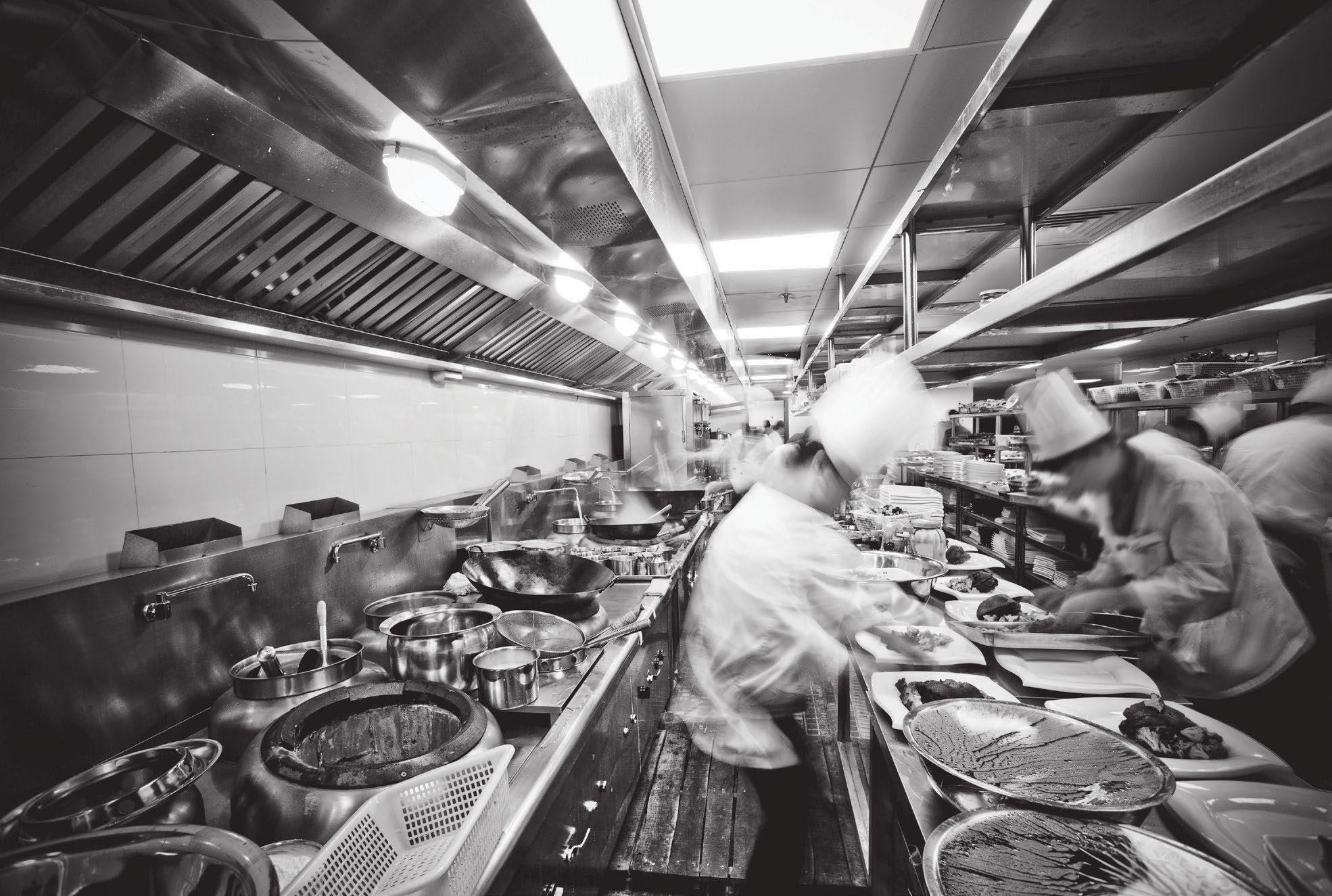









I’ve noticed that one of the hardest things for people to do is to change what they’re doing to something better to be doing, when there’s nothing externally forcing them to. But to unhook from whatever groove we’re in, in the moment, and shift the focus of awareness and physical energies into something that may not be as immediately easy or comfortable … I think that takes real strength.
It seems crazy that getting involved in a more constructive thing to do ever seemed so difficult, once I’ve jumped in. If I can just start to exercise, write in my journal, brainstorm a project, draft an article, review my work, do spiritual practices or go for a walk, it’s all relatively a breeze from there. But just changing the direction of my mental and physical focus when I don’t particularly feel like it … that’s worthy of a Medal of Honor! Until then, I’m like the hero in the movie Top Gun, about to do battle, but frozen (“Engage, Maverick… Engage!”), and I’m hung up in my own psychic knots.
Of course, it’s never that dramatic (or romantic). It might be easier to deal with if it were. Things I’ve done like hitchhike from Istanbul to Karachi, drop out of graduate school, get a black belt and sail solo in heavy weather required some level of guts (and perhaps youthful stupidity!). But as risky as those events seemed at the time, I think they were easier than what I deal with in getting myself to shift my attention and energies into something that I know will be better for me than what I’m doing.
Maybe this is maudlin self-absorption (like, David, is this the biggest problem you’ve GOT?). But how many people let multiple aspects of their life get to crisis mode before they have the motivation to do something about it? Seems it’s easier to let the drama of a problem be our driver than the intuitive sense that we should change the direction of our attention when it would still be early enough to be the ounce of prevention. In other words, dealing with



Over the years, Tyson Foodservice and Burger King have collaborated on successful poultry launches that have become core menu staples and customer favorites. This includes finishing touches like bacon and tortillas. It is an honor to team with Burger King and partner in these crowning achievements.
things when you HAVE to is easier than when they are most productively dealt with.
I’m not interested in being a martyr, however, so I try to stack the deck in my favor. I look for every trick in the book to make it easier to simply get engaged with healthy good stuff. There’s nothing like having great tools in the right places. I got the best yoga costume and props I could find, and I keep them handy at home and in hotel rooms. I bought a great fountain pen that I love to find any excuse to use (like reflecting and writing in my journal). I’ve put nutritional supplements I ought to take regularly right by the water dispenser. I follow my inclination for the coolest organizing gear I can find that attracts me to use it.

by DAVID ALLEN
But no matter how crafty I get at setting up the tricks to tip myself into good-for-me productive activity, I still have to stretch my psychic muscles to break out of a pattern and start the new one. I’m working on developing the habit of immediately jumping into anything I recognize I’m resisting, and out of anything I’m not feeling so good about doing. Doing the different thing is not hard. GETTING myself to do it deserves a medal. n
After decades of in-the-field research and practice of his productivity methods, DAVID ALLEN wrote the international best-seller “Getting Things Done” (GTD). Published in over 28 languages, TIME magazine heralded it as “the defining self-help business book of its time.” In 2015, he released a new edition of the book, with new insights, updates, and discoveries about the GTD methodology and its many personal and professional applications.
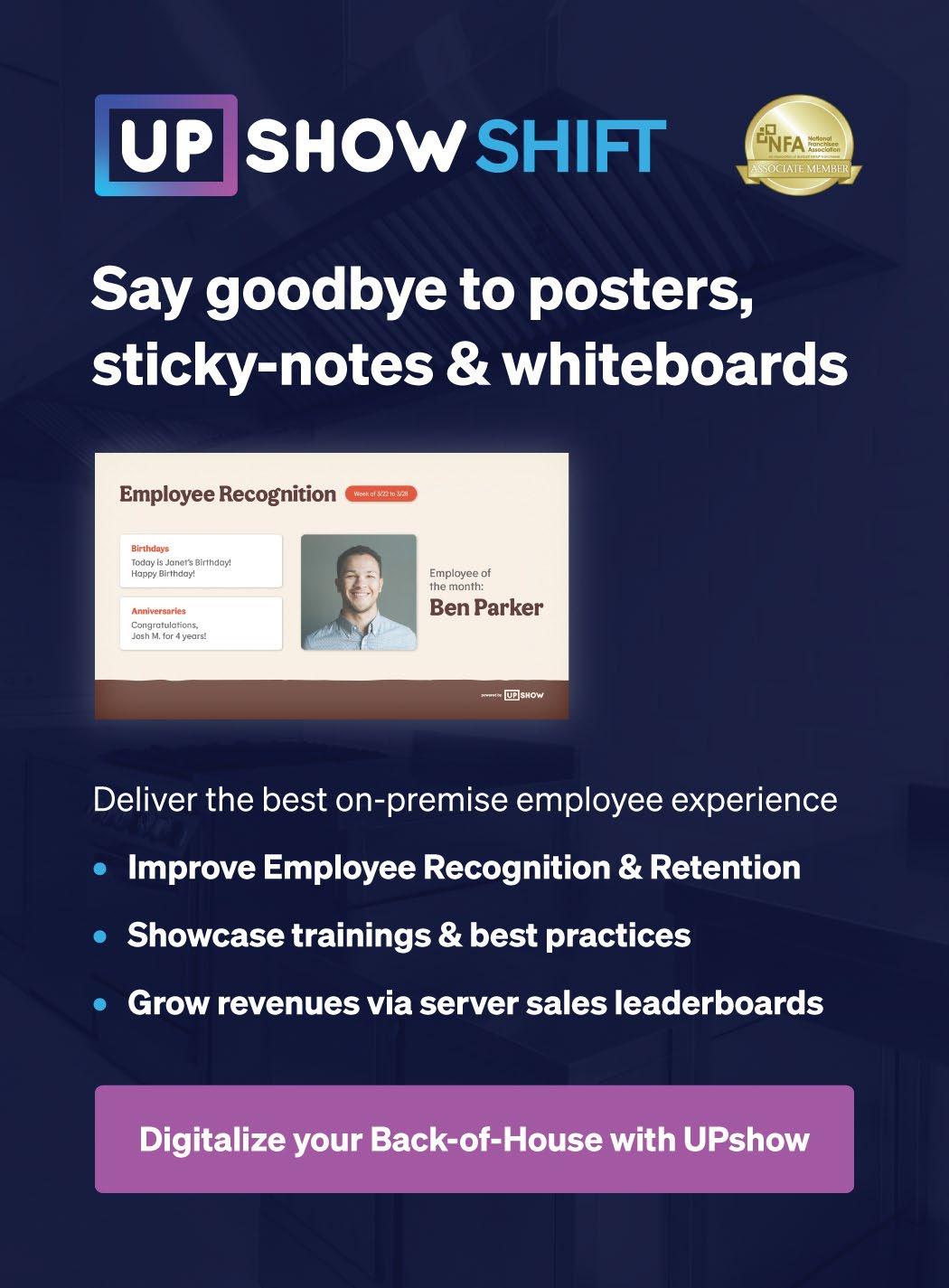





I
n this article, we will cover the recent Department of Labor (DOL) ruling on salary thresholds for exempt status.
The federal DOL ruling focuses on salary thresholds for employees to achieve exempt status. There are two key timelines to be aware of:
1. July 1, 2024: The salary threshold increased from $35,000 to $43,888.
2. January 1, 2025: The threshold will jump to $58,656, a significant 34% increase. Furthermore, starting January 2027, the DOL plans to increase this threshold every three years.
While the focus is often on salary numbers, it’s crucial to revisit job duties. To truly be exempt, it’s not just about salary but also about the roles and responsibilities defined by the executive, administrative, professional and IT job descriptions. The DOL will scrutinize job duties to ensure compliance, not just salary levels.
Employers should document job duties for each role, not just the salary. Job descriptions are vital for proving the type of work performed. The DOL can also interview employees to verify that their duties match the exempt status criteria.
This ruling affects both employers and employees. Exempt status means employees are not eligible for overtime pay.

Employers must decide whether to raise salaries to meet the new thresholds or switch employees to hourly pay with overtime. This decision should consider financial impacts and employee morale. Changing an employee’s status from exempt to non-exempt could be perceived as a demotion.
Employers must also consider state laws, which may have higher thresholds than the federal ones. The ruling is subject to legal challenges, and while the 7/1 threshold is likely to stand, future increases might be contested.
Employers should conduct a financial review to assess the impact of these changes and ensure job duties align with the new thresholds. Engaging with an employment lawyer for roles that are borderline can help ensure compliance and avoid costly mistakes.
The new DOL ruling on salary thresholds for exempt status requires careful consideration by employers. Financial reviews, job duty assessments and understanding employee perspectives are crucial steps. n
For detailed advice and tailored solutions, contact Mize CPAs or consult an employment lawyer. Stay informed and prepared to navigate these significant changes.


All property is important to upkeep and maintain, and the same is true of any property your franchise owns.
Maintaining the property and prioritizing safety improvements not only adds to your property value, but it also keeps your employees and customers safe and comfortable. Read on for property maintenance tips and ways to protect your BURGER KING® property.
• Prepare for a power outage. Whether your restaurant loses power for one day or one week, it is important to prepare for a power outage. Whether caused by ice, snow or thunderstorms, a power outage may cause food spoilage, prevent the use of medical devices and disrupt water and communications.
• Always have an emergency kit with water, non-perishable food, emergency contact information and more.
• Consider purchasing a generator to power essential equipment like freezers and walk-ins. Ensure multiple employees know how to safely operate it.
• Make a disaster plan, including how to respond during an outage, and how employees and customers will be notified of delays.
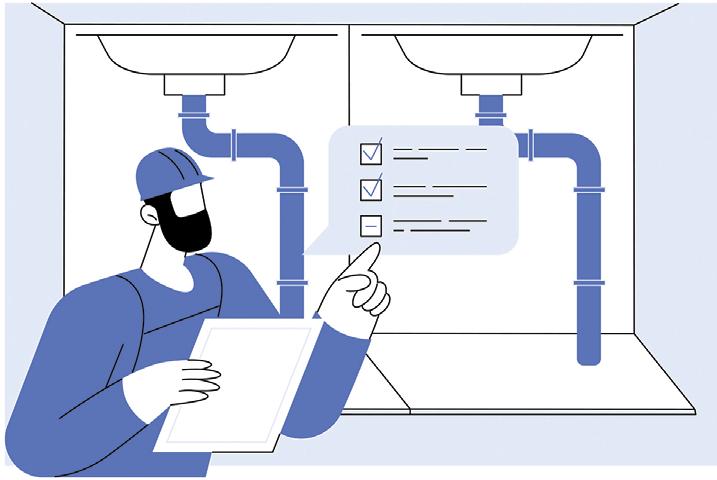



• Improve safety signage. Facilities that have clear and consistent safety signage see a reduction in accidents and injuries. They also minimize their risk of legal action should an accident occur.
• Practice fire safety. Kitchen fires lead to severe revenue loss, property damage and stoppage of operations.
• Keep kitchen equipment clean and train staff on the proper usage of equipment.
• Install the proper smoke detectors, fire extinguishers and fire suppression systems that can shut off power and gas to burners and dispense a Class K chemical where needed.
• Schedule regular testing and maintenance of detectors, extinguishers and systems. Schedule regular maintenance on ovens, fryers, gas mains and more.
• Examine parking lot safety. Parking lots pose risks to cars, pedestrians and property as employees and guests can cause accidents and damage. Look at your parking lot’s accessibility to see if there are adjustments that can be made to prevent accidents and make your restaurant a welcoming place for all.
• Reduce water damage risks. Keeping your business safe and dry can be difficult. Be aware of the risks of water intrusion and take steps to avoid it.
• Fix slow leaks and broken seals at the first detection. Install a water leak detection device.
• Install insulation in attics and crawl spaces to prevent pipes from freezing and bursting.
• Monitor pipes, appliances and sump pumps during power outages.
• In the winter, prevent gutter blockages and ice dams from forming on the roof. Clear excess snow and ice away from doors and windows.

• Prevent employee theft. Theft committed by employees remains a significant risk for restaurants. Without action, you could lose thousands of dollars each year in sales, and in some cases, you may face a claim due to large-scale fraud.
• Focus on your point of sale and consider investing in POS monitoring software.
• Pair POS monitoring software with video surveillance.
• Monitor for suspicious transactions and missing inventory.
• Prevent facility theft. Theft has the potential to impact every part of the operations at your restaurant. With cash, food, electronics and other valuables onsite, restaurants can be a lucrative target for thieves.
• Keep safes and offices closed and locked. Make additional bank deposits if needed.
• Invest in a security alarm and cameras. Check in on the restaurant daily when closed.
While these tips and other risk management resources can help protect your BURGER KING property, the best protection is tailored Property insurance.
With Property insurance from Lockton Affinity, your BURGER KING restaurant can be protected from the costs associated with property damage caused by fire, theft and other perils. Plus, we’re co-brokers with Elevanta, so the coverages offered are designed to protect against the risks Elevanta franchisees face.
Get started today by visiting Elevanta.LocktonAffinity.com. n

The Elevanta Insurance Program is administered by Lockton Affinity, LLC d/b/a Lockton Affinity Insurance Brokers LLC in California #0795478. Coverage is subject to actual policy terms and conditions. Policy benefits are the sole responsibility of the issuing insurance company. Coverage may be provided by an excess/surplus lines insurer which is not licensed by or subject to the supervision of the insurance department of your state of residence. Policy coverage forms and rates are not subject to regulation by the insurance department of your state of residence. Excess/Surplus lines insurers do not generally participate in state guaranty funds and therefore insureds are not protected by such funds in the event of the insurer’s insolvency. Elevanta will receive a royalty fee for the licensing of its name and trademarks as part of the insurance program offered to the extent permitted by applicable law.
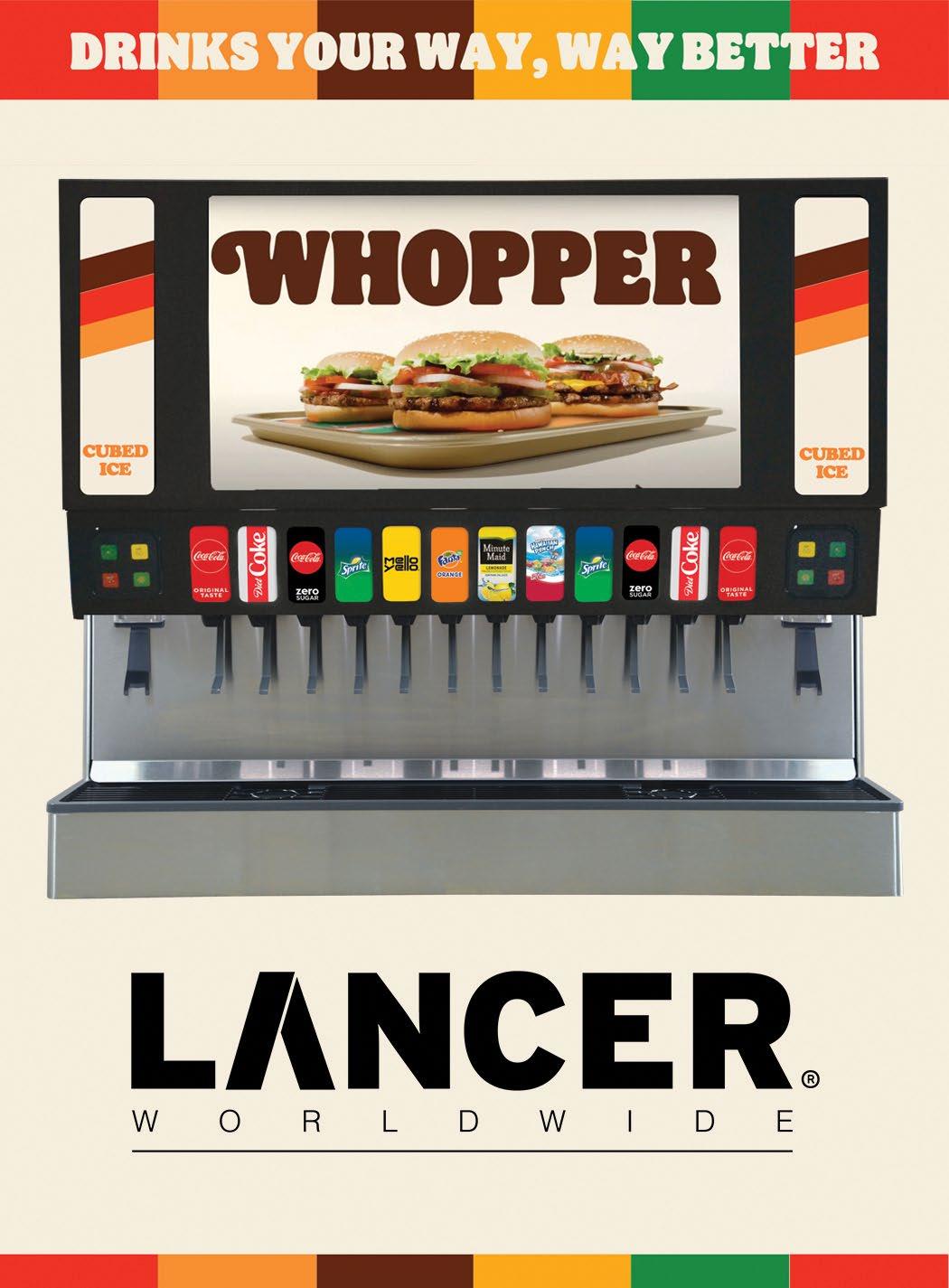



RSI’s Revenue Management Platform (RMP) launched in October 2023 and has quickly become an essential resource for restaurant operators. By providing data-driven insights, RMP empowers members to strategically manage their menu pricing by comparing competitor pricing, modeling price change impacts, and identifying pricing anomalies—ultimately enhancing strategic decision-making and increasing profitability.
One of RMP’s core features, the Market Intelligence Dashboard , offers operators a way to compare their menu prices against selected competitors. The dashboard provides monthly in-store pricing data, and members can subscribe to customizable price alerts to receive notifications when a competitor changes menu pricing past a selected threshold. When a competitor adjusts prices by a chosen percentage or dollar amount, a
Customizable Price Alerts
notification will be sent via text or email, keeping RSI members ahead of market shifts.
RSI is working closely with the BURGER KING ® brand to further develop the Market Intelligence Dashboard, expanding its scope to capture pricing visibility for items not listed on menu boards, such as a WHOPPER ® with cheese. This enhancement will provide a more comprehensive view of competitive pricing opportunities, covering a broader range of menu offerings and customizations and giving members the power to make more strategic pricing decisions.
Additionally, recognizing the challenge of accessing competitor delivery pricing, RSI is developing a feature that will allow operators to view and benchmark their restaurant’s delivery prices against competitors.



This enhancement will provide valuable insights into the delivery landscape, helping members stay informed and competitive in an increasingly important area of their business.
The 3P Delivery pricing view is available with limited data and will be expanded in the future. More details will be shared in an upcoming RSI NewsBrief.
In line with RSI’s commitment to continue delivering
menu pricing. This valuable analysis detects pricing inconsistencies within POS Pricing Tiers, giving operators the opportunity to correct discrepancies that are impacting their bottom line. By analyzing files submitted by operators and applying business rules, RSI is helping pinpoint pricing anomalies across in-restaurant and delivery pricing, helping members protect their profitability.

profitability-driven insights, RMP was further enhanced last winter with the launch of the Modeling Tool. With this tool, operators can view the brand’s suggested menu pricing, make their preferred adjustments, and view how these changes could impact metrics such as average AUVs, Sales Per Day, and Gross Profit on a monthly and annualized basis. Once the user is aligned with the pricing strategy, a pricing file can be exported from RMP and uploaded directly to the SICOM/Xenial Point-of-Sale (POS) system.
In the spring of 2024, RSI introduced and added the Pricing Anomaly Analysis to the platform, quickly gaining traction among members for its ability to identify anomalies in restaurant
Member profitability will remain a core priority for RSI, and we will continue to develop RMP as a powerful resource for driving restaurant pricing strategies. We encourage RSI members to use the platform to the fullest extent. If you have any questions or need help using the platform, please contact the RSI Help Desk at helpdesk@rsilink.com or 305-529-2123.
Restaurant Services, Inc. (RSI), at www.rsiweb.com, is the supply chain manager for the BURGER KING® system and the exclusive purchasing agent for the vast majority of products and distribution services used by RSI's members — BURGER KING® restaurant owners in the United States. n





All restaurant owners know technology drives stellar sales and customer relations. Even at the drive-thru window, the right tools matter.
All restaurant owners know technology drives stellar sales and customer relations. Even at the drive-thru window, the right tools matter.
Consider, for example, the gear your employees rely on to meet your customers’ high expectations. Old, clunky, outdated headsets are not only uncomfortable to wear they also compromise your team’s ability to communicate with consumers daily.
Consider, for example, the gear your employees rely on to meet your customers’ high expectations. Old, clunky, outdated headsets are not only uncomfortable to wear they also compromise your team’s ability to communicate with consumers daily
Those familiar with Xenial know its robust catalog includes our muchloved Xenial Back Office platform. Now, Xenial has part-nered with Quail Digital and em-p owered restaurant owners with an integrated hands-free peripheral that addresses all of these issues and more.
Those familiar with Xenial know its robust catalog includes our muchloved Xenial Back Office platform. Now, Xenial has part-nered with Quail Digital and em-p owered restaurant owners with an integrated hands-free peripheral that addresses all of these issues and more.
Why upgrade your headsets?
Why upgrade your headsets?
Better audio quality and lightning-fast communication can speak volumes when interfacing with your customers. Even if you already love Quail, you’ll find that the Pro9 series offers much more in the way of comfort, ergonomics and wearability. Our lightweight, non-slip design is unparalleled throughout the industry.
Better audio quality and lightning-fast communication can speak volumes when interfacing with your customers. Even if you already love Quail, you’ll find that the Pro9 series offers much more in the way of comfort, ergonomics and wearability. Our lightweight, non-slip design is unparalleled throughout the industry.
Unlike other major competing brands, the Pro9 system is entirely configurable to your restaurant’s specific needs. Assign individual employees to
Unlike other major competing brands, the Pro9 system is entirely configurable to your restaurant’s specific needs. Assign individual employees to



specific lanes, or utilize our proprietary 4 Lane System. This system keeps your team on standby until an order request triggers an alert, freeing others to perform other important tasks instead of watching a screen idly This revolutionary protocol is the first of its kind.
specific lanes, or utilize our proprietary 4 Lane System. This system keeps your team on standby until an order request triggers an alert, freeing others to perform other important tasks instead of watching a screen idly This revolutionary protocol is the first of its kind.
Our multi-channel hands-free headsets allow for effective communication between all parties involved, including between your team members themselves. No matter how large your production floor is, our collaboration with Quail ensures that your entire staff will be well accommodated. W e deliver long-range cover-a ge that supports a clear signal across parking lots, multi-story establishments, and even very large commercial spaces.
Our multi-channel hands-free headsets allow for effective communication between all parties involved, including between your team members themselves. No matter how large your production floor is, our collaboration with Quail ensures that your entire staff will be well accommodated. W e deliver long-range cover-a ge that supports a clear signal across parking lots, multi-story establishments, and even very large commercial spaces.
What de fi nes your customers’ ideal quick service experience?
What de fi nes your customers’ ideal quick service experience?
Old-school drive-thru systems traditionally digitize an analog signal, resulting in poor audio quality, distortion and, often, a frustrated customer. Xenial has addressed this issue entirely with the help of Quail’s Pro9 system.
Old-school drive-thru systems traditionally digitize an analog signal, resulting in poor audio quality, distortion and, often, a frustrated customer. Xenial has addressed this issue entirely the help of Quail’s Pro9
Our headsets boast a Speech Transmission Index (STI) of 0.57, as well as an Inbound Noise Cancellation rating of 23dB — that’s nearly 50% more effective than the standard HME HD system.
Our headsets boast a Transmission Index 0.57, as well as an Noise Cancellation rating of 23dB — that’s nearly 50% more effective than the standard HME HD system.
Dedicated hardware at the drive-thru window now captures a digital signal from the very beginning, delivering it to the back of the house at the highest possible technical standard. You’ll find that your customers are easier to understand than ever, and that value goes both ways. High-quality audio means fewer order-taking errors and less time spent clarifying. That means your employees can concentrate on accuracy, speed and upselling.
Dedicated hardware at the drive-thru window now captures a digital signal from the very beginning, delivering it to the back of the house at the highest possible technical standard. You’ll find that your customers are easier to understand than ever, and that value goes both ways. High-quality audio means fewer order-taking errors and less time spent clarifying. That means your employees can concentrate on accuracy, speed and upselling.
E xperience the difference yourself, on your terms. It’s not always easy to keep your operation running smoothly, but the right tools can help. Our unique approach saves you time and money every single day of th e week, and our 3-year wa rranty guarantees complete satisfaction and continued support for your business.
E xperience the difference yourself, on your terms. It’s not always easy to keep your operation running smoothly, but the right tools can help. Our unique approach saves you time and money every single day of th e week, and our 3-year ranty


Xenial is a sapphire partner member of National Franchisee Association. Smarter technology Industry-leading performance. When you’re running a restaurant, every trans-action matters. Xenial strives to ensure that nothing stands be-tween your customers and the best service your team has to offer. Our brand is constantly adapting to an evolving industry, providing tech-nology that keeps your growing business on track. Visit https://www.xenial.com

2024
Blue Triton Brands 3 800-274-5282 customerservice@readyrefresh.com BURGER KING FoundationSM 23 bgarcia2@whopper.com www.burgerkingfoundation.org
Comcast
Ecolab 21 800-529-5458 www.ecolab.com
Gycor International 33 800-772-0660 www.gycorfilters.com
Hall Financial Advisors 15 866-865-4442 www.hallfa.com
Keurig Dr Pepper BC 770-789-8266 josh.hanley@kdrp.com
Lancer Worldwide 41 800-729-1500 www.lancerworldwide.com/flame
Lockton Affinity IF 844-403-4947 www.Elevanta.LocktonAffinity.com
National Franchise Sales
949-428-0492 md@nationalfranchisesales.com Panasonic Connect North America 13 877-726-2767 www.na.panasonic.com
PAR 22 619-333-5060 X: 8273 www.partech.com rapid! 31 888-828-2270 www.rapidpaycard.com
Restaurant365 21 949-652-7800 www.restaurant365.com/burger-king


Restaurant Technologies 8 954-612-8086 www.rti-inc.com/burger-king Shift 37 419-261-1802 www.upshow.tv
Simplot 35 704-907-6522 www.simplotfoods.com
The Coca-Cola Co. 11 404-852-5399 skmiller@coca-cola.com
The Hershey Co. 35 704-607-8745 www.hersheyfoodservice.com
Tyson Foods 37 410-340-3974 www.tysonfoods.com
Upside 39 303-995-0088 www.upside.com
Welbilt 39 817-760-6240 www.welbilt.com
Xenial 7 800-253-8664 www.xenial.com
* IF=Inside Front, IB=Inside Back, BC=Back Cover
ISSUE AD ARTWORK PUBLICATION DEADLINE DATE 4 Nov. 1 December
FLAME , Issue 4 will be published in December 2024. We want to highlight any news or events associated with our members. If you have ideas for potential stories, please contact communications@nfabk.org or 678-797-5165 by Nov. 1. Our editorial staff can assist in writing the story for you.

